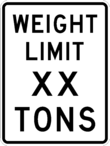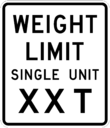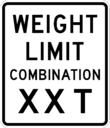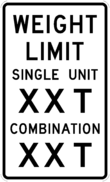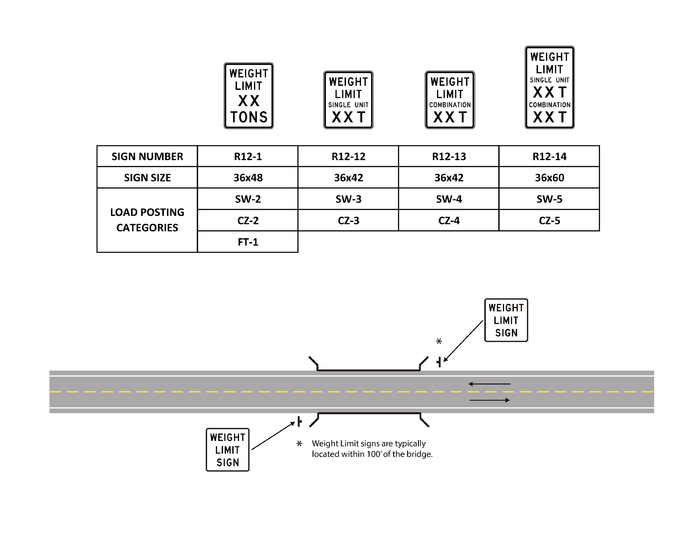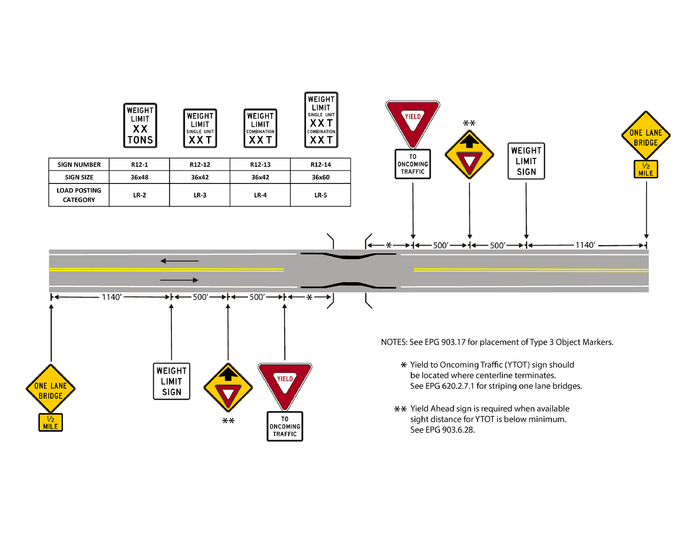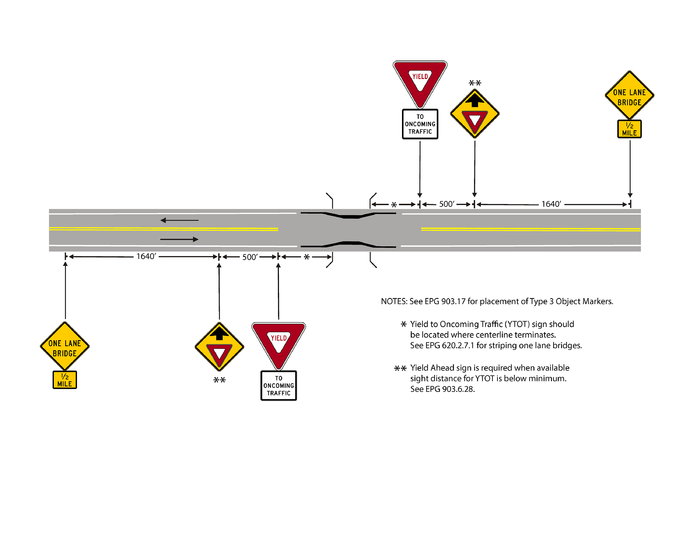903.5 Regulatory Signs: Difference between revisions
→903.5.5.2 YIELD Sign Placement (MUTCD Section 2B.10): updated per RR3755 |
|||
| (18 intermediate revisions by 3 users not shown) | |||
| Line 8: | Line 8: | ||
|'''Additional Information''' | |'''Additional Information''' | ||
|- | |- | ||
|[ | |[https://epg.modot.org/files/1/1d/949.2_speed_limits.pdf How Speed Limits are Established] | ||
|} | |} | ||
| Line 19: | Line 19: | ||
Regulatory signs shall be installed at or near where the regulations apply. The signs shall clearly indicate the requirements imposed by the regulations and shall be designed and installed to provide adequate visibility and legibility in order to obtain compliance. | Regulatory signs shall be installed at or near where the regulations apply. The signs shall clearly indicate the requirements imposed by the regulations and shall be designed and installed to provide adequate visibility and legibility in order to obtain compliance. | ||
Regulatory signs shall be retroreflective or illuminated (see [ | Regulatory signs shall be retroreflective or illuminated (see [https://epg.modot.org/index.php?title=903.2_Extent_of_Signing#903.2.17_Retroreflectivity_and_Illumination_.28MUTCD_Section_2A.07.29 EPG 903.2.17, Retroreflectivity and Illumination]) to show the same shape and similar color by both day and night, unless specifically stated otherwise in the text discussion of this article for a particular sign or group of signs. | ||
The requirements for sign illumination shall not be considered to be satisfied by street or highway lighting. | The requirements for sign illumination shall not be considered to be satisfied by street or highway lighting. | ||
| Line 33: | Line 33: | ||
'''Support.''' The use of educational plaques to supplement symbol signs is described in [[903.2 Extent of Signing#903.2.14 Symbols (MUTCD Section 2A.12)|EPG 903.2.14, Symbols]]. | '''Support.''' The use of educational plaques to supplement symbol signs is described in [[903.2 Extent of Signing#903.2.14 Symbols (MUTCD Section 2A.12)|EPG 903.2.14, Symbols]]. | ||
'''Guidance.''' [ | '''Guidance.''' [https://epg.modot.mo.gov/index.php?title=616.6_Temporary_Traffic_Control_Zone_Devices_%28MUTCD_6F%29#616.6.60_Portable_Changeable_Message_Signs_.28MUTCD_6F.60.29 Changeable Message signs] displaying a regulatory message incorporating a prohibitory message that includes a red circle and slash on a static sign should display a red symbol that approximates the same red circle and slash as closely as possible. | ||
==903.5.3 Dimensions ([https://mutcd.fhwa.dot.gov/ MUTCD] Section 2B.03)== | ==903.5.3 Dimensions ([https://mutcd.fhwa.dot.gov/ MUTCD] Section 2B.03)== | ||
| Line 39: | Line 39: | ||
'''Standard.''' Except as provided in [[903.2 Extent of Signing#903.2.13 Dimensions (MUTCD Section 2A.11)|EPG 903.2.13]], the sizes for regulatory signs shall be as shown in Table 903.5.3, below. | '''Standard.''' Except as provided in [[903.2 Extent of Signing#903.2.13 Dimensions (MUTCD Section 2A.11)|EPG 903.2.13]], the sizes for regulatory signs shall be as shown in Table 903.5.3, below. | ||
'''Support.''' [ | '''Support.''' [https://epg.modot.org/index.php?title=903.2_Extent_of_Signing#903.2.21_Dimensions_.28MUTCD_Section_2A.11.29 EPG 903.2.13] contains information regarding the applicability of the various columns in Table 903.5.3. | ||
'''Standard.''' The minimum sizes for regulatory signs facing traffic on multi-lane conventional roads shall be as shown in the multi-lane column of Table 903.5.3. | '''Standard.''' The minimum sizes for regulatory signs facing traffic on multi-lane conventional roads shall be as shown in the multi-lane column of Table 903.5.3. | ||
| Line 270: | Line 270: | ||
|- | |- | ||
!Noise Ordinance | !Noise Ordinance | ||
|| | ||R5-21 ||[[#903.5.43 Noise Ordinance Signing|903.5.43]]|| 30 X 24|| 30 X 24|| 36 X 30|| 36 X 30 | ||
|- | |- | ||
!No More Trash | !No More Trash | ||
| Line 369: | Line 369: | ||
===903.5.4.2 STOP Sign Placement ([https://mutcd.fhwa.dot.gov/ MUTCD] Section 2B.10)=== | ===903.5.4.2 STOP Sign Placement ([https://mutcd.fhwa.dot.gov/ MUTCD] Section 2B.10)=== | ||
'''Standard.''' The STOP sign shall be installed on the near side of the intersection on the right-hand side of the approach to which it applies. When the STOP sign is installed at this required location and the sign visibility is restricted, a Stop Ahead sign (see [ | '''Standard.''' The STOP sign shall be installed on the near side of the intersection on the right-hand side of the approach to which it applies. When the STOP sign is installed at this required location and the sign visibility is restricted, a Stop Ahead sign (see [https://epg.modot.org/index.php/903.6_Warning_Signs#903.6.28_Advance_Traffic_Control_Signs_.28W3-1.2C_W3-2.2C_W3-3.2C_W3-4.29_.28MUTCD_Section_2C.36.29 EPG 903.6.28 Advance Traffic Control Signs]) shall be installed in advance of the STOP sign. | ||
The STOP sign shall be located as close as practical to the intersection it regulates, while optimizing its visibility to the road user it is intended to regulate. | The STOP sign shall be located as close as practical to the intersection it regulates, while optimizing its visibility to the road user it is intended to regulate. | ||
| Line 403: | Line 403: | ||
'''Support.''' Multiway stop control can be useful as a safety measure at intersections if certain traffic conditions exist. Safety concerns associated with multiway stops include pedestrians, bicyclists, and all road users expecting other road users to stop. Multiway stop control is used where the volume of traffic on the intersecting roads is approximately equal. | '''Support.''' Multiway stop control can be useful as a safety measure at intersections if certain traffic conditions exist. Safety concerns associated with multiway stops include pedestrians, bicyclists, and all road users expecting other road users to stop. Multiway stop control is used where the volume of traffic on the intersecting roads is approximately equal. | ||
The restrictions on the use of STOP signs described in [ | The restrictions on the use of STOP signs described in [https://epg.modot.org/index.php/903.5_Regulatory_Signs#903.5.4.1_STOP_Sign_Applications_.28MUTCD_Section_2B.06.29 EPG 903.5.4.1] also apply to multiway stop applications. | ||
'''Guidance.''' The decision to install multiway stop control should be based on an engineering study. The following criteria should be considered in the engineering study for a multiway STOP sign installation: | '''Guidance.''' The decision to install multiway stop control should be based on an engineering study. The following criteria should be considered in the engineering study for a multiway STOP sign installation: | ||
| Line 458: | Line 458: | ||
D. An intersection where a special problem exists and where engineering judgment indicates the problem to be susceptible to correction by the use of the YIELD sign. | D. An intersection where a special problem exists and where engineering judgment indicates the problem to be susceptible to correction by the use of the YIELD sign. | ||
E. Facing the entering roadway for a merge-type movement if engineering judgment indicates that control is needed because acceleration geometry and/or sight distance is not adequate for merging traffic operation. (See [[903. | E. Facing the entering roadway for a merge-type movement if engineering judgment indicates that control is needed because acceleration geometry and/or sight distance is not adequate for merging traffic operation. (See [[903.16 Typical Signing Applications#Figure 903.16.23 Location of Yield and Lane Ends Sign for Acceleration Ramps|EPG 903.16.23 Location of Yield and Lane Ends Sign for Acceleration Ramps]] for additional information.) | ||
'''Standard.''' A YIELD (R1-2) sign shall be used to assign right of way at the entrance to a roundabout. YIELD signs at roundabouts shall be used to control the approach roadways and shall not be used to control the circulatory roadway. Other than for all of the approaches to a roundabout, YIELD signs shall not be placed on all of the approaches to an intersection. | '''Standard.''' A YIELD (R1-2) sign shall be used to assign right of way at the entrance to a roundabout. YIELD signs at roundabouts shall be used to control the approach roadways and shall not be used to control the circulatory roadway. Other than for all of the approaches to a roundabout, YIELD signs shall not be placed on all of the approaches to an intersection. | ||
| Line 470: | Line 470: | ||
YIELD signs shall not be mounted on the same post. | YIELD signs shall not be mounted on the same post. | ||
No items other than inventory stickers, sign installation dates, and bar codes shall be affixed to the fronts of YIELD signs, and the placement of these items shall be in the border of the sign. | No items other than inventory stickers, sign installation dates, and bar codes shall be affixed to the fronts of YIELD signs, and the placement of these items shall be in the border of the sign. No items other than official traffic control signs, inventory stickers, sign installation dates, anti-vandalism stickers, and bar codes shall be mounted on the backs of YIELD signs. No items other than retroreflective strips or official traffic control signs shall be mounted on the fronts or backs of YIELD sign supports. | ||
YIELD signs shall not be used on Freeways and Expressways where there is | YIELD signs shall not be used on Freeways and Expressways where there is more than 600 ft. of an acceleration lane, measured from the outside ramp curve point at the beginning of the acceleration lane to the end of the taper. When used on Freeways and Expressways, a 60-in. YIELD (R1-2) sign shall be used. | ||
YIELD signs shall be used at a cloverleaf interchange where the in-loop traffic merges with the acceleration and deceleration traffic movement. In these cases, a 60-in. YIELD (R1-2) sign shall be utilized. | YIELD signs shall be used at a cloverleaf interchange where the in-loop traffic merges with the acceleration and deceleration traffic movement. In these cases, a 60-in. YIELD (R1-2) sign shall be utilized. | ||
| Line 543: | Line 543: | ||
An advisory speed plaque mounted below a warning sign should be used to warn road users of an advisory speed for a roadway condition. A Speed Limit sign should not be used for this situation. | An advisory speed plaque mounted below a warning sign should be used to warn road users of an advisory speed for a roadway condition. A Speed Limit sign should not be used for this situation. | ||
'''Support.''' Advisory Speed signs are discussed in [ | '''Support.''' Advisory Speed signs are discussed in [https://epg.modot.org/index.php?title=903.6_Warning_Signs#903.6.36_Advisory_Exit_and_Ramp_Speed_Signs_.28W13-2_and_W13-3.29_.28MUTCD_Section_2C.14.29 EPG 903.6.36] and [https://epg.modot.org/index.php?title=903.6_Warning_Signs#903.6.46_Advisory_Speed_Supplemental_Plaque_.28W13-1P.29_.28MUTCD_Section_2C.08.29 EPG 903.6.46] and Temporary Traffic Control Zone Speed signs are discussed in [[616.23 Traffic Control for Field Operations|the MoDOT Traffic Control for Field Operations]]. | ||
==903.5.8 Combination Speed Limit Sign (R2-4a)== | ==903.5.8 Combination Speed Limit Sign (R2-4a)== | ||
| Line 735: | Line 735: | ||
Optional Movement Lane Control signs shall be used for two or more movements from a specific lane where a movement, not normally allowed, is permitted. The Optional Movement Lane Control sign shall not be used alone to affect a turn prohibition. | Optional Movement Lane Control signs shall be used for two or more movements from a specific lane where a movement, not normally allowed, is permitted. The Optional Movement Lane Control sign shall not be used alone to affect a turn prohibition. | ||
Where the number of lanes available to through traffic on an approach is three or more, an Optional Movement Lane Control (R3-6) sign, if used, shall be mounted overhead over the specific lane to which it applies (see [[#903.5.12 Intersection Lane Control Signs (R3-5 through R3-8) (MUTCD Section 2B.19|EPG 903.5.12]]). | Where the number of lanes available to through traffic on an approach is three or more, an Optional Movement Lane Control (R3-6) sign, if used, shall be mounted overhead over the specific lane to which it applies (see [[#903.5.12 Intersection Lane Control Signs (R3-5 through R3-8) (MUTCD Section 2B.19)|EPG 903.5.12]]). | ||
Because more than one movement is permitted from the lane, the word message ONLY shall not be used on an Optional Movement Lane Control sign. | Because more than one movement is permitted from the lane, the word message ONLY shall not be used on an Optional Movement Lane Control sign. | ||
'''Option.''' The word message OK may be used within the border in combination with the arrow symbols of the R3-6 sign. | '''Option.''' The word message OK may be used within the border in combination with the arrow symbols of the R3-6 sign. | ||
==903.5.15 Two-Way Left Turn Only/Center Lane Only Signs (R3-9a, R3-9b)([https://mutcd.fhwa.dot.gov/ MUTCD] Section 2B.24)== | ==903.5.15 Two-Way Left Turn Only/Center Lane Only Signs (R3-9a, R3-9b)([https://mutcd.fhwa.dot.gov/ MUTCD] Section 2B.24)== | ||
| Line 831: | Line 831: | ||
[[image:R5-1.gif|center|thumb|<center>'''R5-1'''</center>|125px]] | [[image:R5-1.gif|center|thumb|<center>'''R5-1'''</center>|125px]] | ||
'''Standard.''' The DO NOT ENTER (R5-1) sign shall be used where traffic is prohibited from entering a restricted roadway. If the sign is mounted behind a STOP or YIELD sign, the 36-in. DO NOT ENTER sign shall be used behind a 48 in. STOP sign and a 30 in. DO NOT ENTER sign shall be used behind a | '''Standard.''' The DO NOT ENTER (R5-1) sign shall be used where traffic is prohibited from entering a restricted roadway. If the sign is mounted behind a STOP or YIELD sign, the 36-in. DO NOT ENTER sign shall be used behind a 48 in. STOP sign and a 30 in. DO NOT ENTER sign shall be used behind a 60-in. YIELD sign. | ||
'''Guidance.''' The DO NOT ENTER sign, if used, should be placed directly in view of a road user at the point where a road user could wrongly enter a divided highway, one-way roadway, or ramp. The sign should be mounted on the right-hand side of the roadway, facing traffic that might enter the roadway or ramp in the wrong direction. | '''Guidance.''' The DO NOT ENTER sign, if used, should be placed directly in view of a road user at the point where a road user could wrongly enter a divided highway, one-way roadway, or ramp. The sign should be mounted on the right-hand side of the roadway, facing traffic that might enter the roadway or ramp in the wrong direction. | ||
| Line 843: | Line 843: | ||
[[image:R5-1a.gif|center|thumb|<center>'''R5-1a'''</center>|105px]] | [[image:R5-1a.gif|center|thumb|<center>'''R5-1a'''</center>|105px]] | ||
'''Option.''' The WRONG WAY (R5-1a) sign may be used as a supplement to the DO NOT ENTER sign where an exit ramp intersects a crossroad or a crossroad intersects a one-way roadway in a manner that does not physically discourage or prevent wrong-way entry. See [[903. | '''Option.''' The WRONG WAY (R5-1a) sign may be used as a supplement to the DO NOT ENTER sign where an exit ramp intersects a crossroad or a crossroad intersects a one-way roadway in a manner that does not physically discourage or prevent wrong-way entry. See [[903.16 Typical Signing Applications|EPG 903.16 Typical Signing Applications]] for typical placements of WRONG WAY signs. | ||
'''Guidance.''' If used, the WRONG WAY sign should be placed at a location along the exit ramp or the one-way roadway farther from the crossroad than the DO NOT ENTER sign (see [[#903.5.24 Wrong-Way Traffic Control at Interchange Ramps (MUTCD Section 2B.41)|EPG 903.5.24]]). | '''Guidance.''' If used, the WRONG WAY sign should be placed at a location along the exit ramp or the one-way roadway farther from the crossroad than the DO NOT ENTER sign (see [[#903.5.24 Wrong-Way Traffic Control at Interchange Ramps (MUTCD Section 2B.41)|EPG 903.5.24]]). | ||
| Line 933: | Line 933: | ||
||[[image:R6-2.jpg|left|thumb|<center>'''R6-2'''</center>|95px]] | ||[[image:R6-2.jpg|left|thumb|<center>'''R6-2'''</center>|95px]] | ||
|} | |} | ||
'''Standard.''' Except as provided in the Option below, the ONE WAY (R6-1 or R6-2) sign shall be used to indicate streets or roadways upon which vehicular traffic is allowed to travel in one direction only. ONE WAY signs shall be placed parallel to the one-way street at all access points that intersect one-way roadways as shown in [[903. | '''Standard.''' Except as provided in the Option below, the ONE WAY (R6-1 or R6-2) sign shall be used to indicate streets or roadways upon which vehicular traffic is allowed to travel in one direction only. ONE WAY signs shall be placed parallel to the one-way street at all access points that intersect one-way roadways as shown in [[903.16 Typical Signing Applications|EPG 903.16 Typical Signing Applications]]. | ||
At an intersection with a divided highway that has a median width at the intersection itself of 30 ft. or more, ONE WAY signs shall be placed, visible to each crossroad approach, on the near right and far left corners of each intersection with the directional roadways. | At an intersection with a divided highway that has a median width at the intersection itself of 30 ft. or more, ONE WAY signs shall be placed, visible to each crossroad approach, on the near right and far left corners of each intersection with the directional roadways. | ||
| Line 941: | Line 941: | ||
'''Option.''' ONE WAY signs may be omitted on the one-way roadways of divided highways, where the design of interchanges indicates the direction of traffic on the separate roadways. The ONE WAY (R6-2) signs may be used in lieu of the ONE WAY (R6-1) signs on mast arms for signals or where lateral space is limited. | '''Option.''' ONE WAY signs may be omitted on the one-way roadways of divided highways, where the design of interchanges indicates the direction of traffic on the separate roadways. The ONE WAY (R6-2) signs may be used in lieu of the ONE WAY (R6-1) signs on mast arms for signals or where lateral space is limited. | ||
'''Standard.''' If used, at unsignalized intersections, with one-way streets, ONE WAY signs shall be placed on the near right and the far left corners of the intersection facing traffic entering or crossing the one-way street (see [[903. | '''Standard.''' If used, at unsignalized intersections, with one-way streets, ONE WAY signs shall be placed on the near right and the far left corners of the intersection facing traffic entering or crossing the one-way street (see [[903.16 Typical Signing Applications|EPG 903.16 Typical Signing Applications]]). | ||
If used at signalized intersections, with one-way streets, ONE WAY signs shall be placed near the appropriate signal faces, on the poles holding the traffic signals, on the mast arm or span wire holding the signals, or at the locations specified for unsignalized intersections. | If used at signalized intersections, with one-way streets, ONE WAY signs shall be placed near the appropriate signal faces, on the poles holding the traffic signals, on the mast arm or span wire holding the signals, or at the locations specified for unsignalized intersections. | ||
At unsignalized T-intersections where the roadway at the top of the T-intersection is a one-way roadway, ONE WAY signs shall be placed on the near right and the far side of the intersection facing traffic on the stem approach (see EPG 903. | At unsignalized T-intersections where the roadway at the top of the T-intersection is a one-way roadway, ONE WAY signs shall be placed on the near right and the far side of the intersection facing traffic on the stem approach (see EPG 903.16 Typical Signing Applications). | ||
At signalized T-intersections where the roadway at the top of the T-intersection is a one-way roadway, ONE WAY signs shall be placed near the appropriate signal faces on the poles holding the traffic signals, on the mast arm or span wire holding the signals, or at the locations specified for unsignalized intersections. | At signalized T-intersections where the roadway at the top of the T-intersection is a one-way roadway, ONE WAY signs shall be placed near the appropriate signal faces on the poles holding the traffic signals, on the mast arm or span wire holding the signals, or at the locations specified for unsignalized intersections. | ||
| Line 961: | Line 961: | ||
C. At least one WRONG WAY sign shall be placed on the exit ramp facing a traveler traveling in the wrong direction. | C. At least one WRONG WAY sign shall be placed on the exit ramp facing a traveler traveling in the wrong direction. | ||
'''Guidance.''' In addition, the following pavement markings should be used (see [ | '''Guidance.''' In addition, the following pavement markings should be used (see [https://epg.modot.org/index.php?title=903.5_Regulatory_Signs#903.5.21_WRONG_WAY_Sign_.28R5-1a.29_.28MUTCD_Section_2B.38.29 Figure 903.5.21.1]): | ||
A. On two-lane paved crossroads at interchanges, double solid yellow lines should be used as a center line for an adequate distance on both sides approaching the ramp intersections. | A. On two-lane paved crossroads at interchanges, double solid yellow lines should be used as a center line for an adequate distance on both sides approaching the ramp intersections. | ||
| Line 973: | Line 973: | ||
B. Additional WRONG WAY signs may be used. | B. Additional WRONG WAY signs may be used. | ||
C. Slender, elongated wrong-way arrow pavement markings (see [ | C. Slender, elongated wrong-way arrow pavement markings (see [https://epg.modot.org/index.php?title=620.2_Pavement_and_Curb_Markings_%28MUTCD_Chapter_3B%29#620.2.20_Pavement_Word.2C_Symbol_and_Arrow_Markings_.28MUTCD_Section_3B.20.29 EPG 620.2.20]) intended primarily to warn wrong-way travelers that they are traveling in the wrong direction may be placed upstream from the ramp terminus (see [https://epg.modot.org/index.php?title=903.5_Regulatory_Signs#903.5.21_WRONG_WAY_Sign_.28R5-1a.29_.28MUTCD_Section_2B.38.29 Fig. 903.5.21.1]) to indicate the correct direction of traffic flow. Wrong-way arrow pavement markings may also be placed on the exit ramp at appropriate locations near the crossroad junction to indicate wrong-way movement. The wrong-way arrow markings may consist of pavement markings or bidirectional red-and-white raised pavement markers or other units that show red to wrong-way travelers and white to other travelers. | ||
D. Lane-use arrow pavement markings may be placed on the exit ramp and crossroad near their intersection to indicate the permissive direction of flow. | D. Lane-use arrow pavement markings may be placed on the exit ramp and crossroad near their intersection to indicate the permissive direction of flow. | ||
'''Guidance.''' On interchange entrance ramps where the ramp merges with the through roadway and the design of the interchange does not clearly make evident the direction of traffic on the separate roadways or ramps, a ONE WAY sign visible to traffic on the entrance ramp and through roadway should be placed on each side of the through roadway near the entrance ramp merging point as illustrated in [ | '''Guidance.''' On interchange entrance ramps where the ramp merges with the through roadway and the design of the interchange does not clearly make evident the direction of traffic on the separate roadways or ramps, a ONE WAY sign visible to traffic on the entrance ramp and through roadway should be placed on each side of the through roadway near the entrance ramp merging point as illustrated in [https://epg.modot.org/index.php?title=903.5_Regulatory_Signs#903.5.21_WRONG_WAY_Sign_.28R5-1a.29_.28MUTCD_Section_2B.38.29 Fig. 903.5.21.2]. | ||
'''Option.''' At locations where engineering judgment determines that a special need exists, other standard warning or prohibitive methods and devices may be used as a deterrent to the wrong-way movement. | '''Option.''' At locations where engineering judgment determines that a special need exists, other standard warning or prohibitive methods and devices may be used as a deterrent to the wrong-way movement. | ||
| Line 1,170: | Line 1,170: | ||
[[image:R8-7.gif|center|150px|thumb|<center>'''R8-7'''</center>]] | [[image:R8-7.gif|center|150px|thumb|<center>'''R8-7'''</center>]] | ||
'''Option.''' The EMERGENCY STOPPING ONLY (R8-7) sign may be used to discourage or prohibit shoulder parking on the interstate and other freeway highway systems based on [https://revisor.mo.gov/main/OneSection.aspx?section=304.024 | '''Option.''' The EMERGENCY STOPPING ONLY (R8-7) sign may be used to discourage or prohibit shoulder parking on the interstate and other freeway highway systems based on [https://revisor.mo.gov/main/OneSection.aspx?section=304.024 Section 304.024 RSMo]. | ||
'''Standard.''' EMERGENCY STOPPING ONLY signs shall be rectangular and have a black legend and border on a white background. | '''Standard.''' EMERGENCY STOPPING ONLY signs shall be rectangular and have a black legend and border on a white background. | ||
| Line 1,249: | Line 1,249: | ||
'''Standard.''' The NO TURN ON RED (R10-11a) sign shall be used to prohibit a right turn on red. | '''Standard.''' The NO TURN ON RED (R10-11a) sign shall be used to prohibit a right turn on red. | ||
'''Guidance.''' The RIGHT TURN SIGNAL (R10-10R) sign should be used when a right turn movement with an exclusive turn lane is protected and controlled by a three-section head consisting of R-Yrt-Rt (see [ | '''Guidance.''' The RIGHT TURN SIGNAL (R10-10R) sign should be used when a right turn movement with an exclusive turn lane is protected and controlled by a three-section head consisting of R-Yrt-Rt (see [https://epg.modot.org/index.php?title=902.5_Traffic_Control_Signal_Features_%28MUTCD_Chapter_4D%29#902.5.31_Signal_Indications_for_Permissive_Only_Mode_Right-Turn_Movements_.28MUTCD_Section_4D.22.29 Fig. 902.5.31]). If used, the NO TURN ON RED sign should mounted adjacent to the far right signal indication. Refer to [[902.5 Traffic Control Signal Features (MUTCD Chapter 4D)#902.5.33 Signal Indications for Protected/Permissive Mode Right-Turn Movements (MUTCD Section 4D.24)|EPG 902.5.33]] to determine when a NO TURN ON RED sign should be considered. | ||
'''Support.''' [[902.6 Pedestrian Control Features (MUTCD Chapter 4E)|EPG 902.6 Pedestrian Control Features]] contains information regarding the application of the R10-32P plaque. | |||
==903.5.31 Photo Enforced Signs and Plaques (R10-18, R10-18a, R10-18aP and R10-19aP) ([https://mutcd.fhwa.dot.gov/ MUTCD] Section 2B.55)== | ==903.5.31 Photo Enforced Signs and Plaques (R10-18, R10-18a, R10-18aP and R10-19aP) ([https://mutcd.fhwa.dot.gov/ MUTCD] Section 2B.55)== | ||
| Line 1,307: | Line 1,309: | ||
==903.5.36 Weight Limit Signs (R12 Series) ([https://mutcd.fhwa.dot.gov/ MUTCD] Section 2B.59)== | ==903.5.36 Weight Limit Signs (R12 Series) ([https://mutcd.fhwa.dot.gov/ MUTCD] Section 2B.59)== | ||
[[image:R12-1. | <div class="flex-container1"> | ||
<div>[[image:R12-1 36x48.png|center|110px|thumb|<center>'''R12-1'''</center>]]</div> | |||
<div>[[image:R12-12 36x42.png|center|110px|thumb|<center>'''R12-12'''</center>]]</div> | |||
<div>[[image:R12-13 36x42.png|center|110px|thumb|<center>'''R12-13'''</center>]]</div> | |||
<div>[[image:R12-14 36x60.png|center|110px|thumb|<center>'''R12-14'''</center>]]</div> | |||
</div> | |||
''' | '''Support.''' In 2022, a new load posting policy was implemented by MoDOT in our EPG. This new policy resulted from a plan of corrective action with FHWA. With this new policy, all structures on the national bridge inventory will be categorized under this new policy within the next 10 years. There are 10,387 structures on the state system. 270 of these structures are major or unusual structures and these will be categorized over the next 10 years. The remaining 10,117 structures consist of 6,940 normal bridges and 3,177 culverts. The normal bridges will be categorized in the next 4 years and the culverts will be reviewed in the last 3 years of the 10 year timeline of the plan. The R12-1 sign remains in use with the remaining MoDOT bridge posting signs being replaced by one of three new three new bridge posting signs in this section. | ||
'''Standard.''' | '''Standard.''' Weight limit signs shall be installed in accordance with the new bridge posting classifications once completed. Signs shall be located in advance of the applicable bridge structure in accordance with (see Table 903.5.36 and Figures 903.5.36.1 to 903.5.36.3). | ||
In commercial zones, bridges with the capacity of more the 65 tons shall not be posted, as normally loads in excess of 65 tons will not occur. | In commercial zones, bridges with the capacity of more the 65 tons shall not be posted, as normally loads in excess of 65 tons will not occur. | ||
Once a bridge has been categorized, the bridge posting signs shall be updated within 30 days of the bridge posting reclassification. This includes installing the correct sign and configuring the sign locations to match the appropriate bridge posting figure (see Fig. 903.5.36.1 to 903.5.36.3). | |||
''' | '''Support.''' If existing weight limit signs need to be replaced prior to a bridge being categorized, contact Highway Safety and Traffic Division, Signing Section, for guidance. | ||
'''903.5.36.1 Weight/Speed Restriction Signing (R12 Series)''' | '''903.5.36.1 Weight/Speed Restriction Signing (R12 Series)''' | ||
{| style=" | <div align="center";> | ||
{| border="1" class="wikitable" style="text-align:center;" | |||
|+ '''''Table 903.5.36 Listing of Bridge Posting Categories''''' | |||
! style="background:#BEBEBE" colspan="6" | Statewide Legal Load Posting Gross Weight Categories | |||
|- | |||
! Classification || Category || Description || Sign Verbiage || Sign || Figure | |||
|- | |||
| Normal Legal || SW-1 || No Posting Required || N/A || N/A || N/A | |||
|- | |||
| Normal Legal || SW-2 || General Gross Weight Limit || Weight Limit XX Tons || R12-1 || 903.5.36.1 | |||
|- | |||
| Normal Legal || SW-3 || Single Unit Vehicle Gross Weight Limit || Weight Limit Single Unit XX Tons || R12-12 || 903.5.36.1 | |||
|- | |||
| Normal Legal || SW-4 || Combination Vehicle Gross Weight Limit || Weight Limit Combination XX Tons || R12-13 || 903.5.36.1 | |||
|- | |||
| Normal Legal || SW-5 || Single Unit Vehicle and Combination Vehicle Gross Weight Limits || Weight Limit Single Unit XX Tons Combination XX Tons || R12-14 || 903.5.36.1 | |||
|- | |||
| colspan="6" | </br> | |||
|- | |||
! style="background:#BEBEBE" colspan="6" | Statewide Legal Load Posting Centerline Restriction with Gross Weight Categories | |||
|- | |- | ||
| | ! Classification || Category || Description || Sign Verbiage || Sign || Figure | ||
|| | |||
|- | |- | ||
| | | Lane Restricted || LR-1 || Lane Restriction Only || N/A || N/A || 903.5.36.3 | ||
|| | |||
|| | |||
|- | |- | ||
| | | Lane Restricted || LR-2 || Lane Restriction with General Gross Weight Limit || Weight Limit XX Tons || R12-1 || 903.5.36.2 | ||
|| | |||
|- | |- | ||
| Lane Restricted || LR-3 || Lane Restriction with Single Unit Vehicle Gross Weight Limit || Weight Limit Single Unit XX Tons || R12-12 || 903.5.36.2 | |||
|- | |||
| | |||
|- | |- | ||
| | | Lane Restricted || LR-4 || Lane Restriction with Combination Vehicle Gross Weight Limit || Weight Limit Combination XX Tons || R12-13 || 903.5.36.2 | ||
|- | |- | ||
| | | Lane Restricted || LR-5 || Lane Restriction with Single Unit Vehicle and Combination Vehicle Gross Weight Limits || Weight Limit Single Unit XX Tons Combination XX Tons || R12-14 || 903.5.36.2 | ||
|- | |- | ||
| | | colspan="6" | </br> | ||
|- | |- | ||
! style="background:#BEBEBE" colspan="6" | Commercial Zone Areas Gross Weight Categories | |||
|- | |- | ||
| | ! Classification || Category || Description || Sign Verbiage || Sign || Figure | ||
|- | |- | ||
| | | Commercial Zone || CZ-1 || No Posting Required || N/A || N/A || N/A | ||
|- | |- | ||
| | | Commercial Zone || CZ-2 || General Gross Weight Limit || Weight Limit XX Tons || R12-1 || 903.5.36.1 | ||
|- | |- | ||
| | | Commercial Zone || CZ-3 || Single Unit Vehicle Gross Weight Limit || Weight Limit Single Unit XX Tons || R12-12 || 903.5.36.1 | ||
|- | |- | ||
| | | Commercial Zone || CZ-4 || Combination Vehicle Gross Weight Limit || Weight Limit Combination XX Tons || R12-13 || 903.5.36.1 | ||
|- | |- | ||
| | | Commercial Zone || CZ-5 || Single Unit Vehicle and Combination Vehicle Gross Weight Limits || Weight Limit Single Unit XX Tons Combination XX Tons || R12-14 || 903.5.36.1 | ||
|- | |- | ||
| | | colspan="6" | </br> | ||
|- | |- | ||
! style="background:#BEBEBE" colspan="6" | Other Miscellaneous Load Posting Categories | |||
|- | |- | ||
| | ! Classification || Category || Description || Sign Verbiage || Sign || Figure | ||
|- | |- | ||
| | | Fire Truck || FT-1|| General Gross Weight Limit for Emergency Vehicles Included in the FAST Act, Federal Reauthorization Bill || Weight Limit XX Tons || R12-1 || 903.5.36.1 | ||
|- | |- | ||
| | | Closed Bridge || K-CD || Closed to All Traffic || N/A || N/A || N/A | ||
|- | |- | ||
| | | Closed Bridge || K-CIF || Closed to All Traffic as the Result of a Critical Inspection Finding || N/A || N/A || N/A | ||
|- | |- | ||
| | | Other || OT-1 || For Local Agency Bridges that have Signage that Doesn't Fit the Normal Legal, Lane Restricted, or Commercial Zone Categories || N/A || N/A || N/A | ||
|- | |- | ||
|} | |} | ||
</div> | |||
<div class="flex-container1"> | |||
[[image: | <div>[[image:Figure 903.5.36.1 Weight Limit Restriction 04-2023.png|center|700px|thumb|<center>'''Fig. 903.5.36.1 Weight Limit Restrictions'''</center>]] </div> | ||
<div>[[image:Figure 903.5.36.2 One Lane Bridge Weight and Width Retriction 4-2023.png|center|700px|thumb|<center>'''Fig. 903.5.36.2 One Lane Bridge Weight and Width Restrictions'''</center>]]</div> | |||
<div>[[image:Figure 903.5.36.3 One Lane Bridge Width Resriction 4-2023.png|center|700px|thumb|<center>'''Fig. 903.5.36.3 One Lane Bridge Width Restrictions'''</center>]]</div> | |||
<div | </div> | ||
[[image: | |||
[[image: | |||
==903.5.37 Weigh Station Signs (R13 series) ([https://mutcd.fhwa.dot.gov/ MUTCD] Section 2B.60)== | ==903.5.37 Weigh Station Signs (R13 series) ([https://mutcd.fhwa.dot.gov/ MUTCD] Section 2B.60)== | ||
| Line 1,496: | Line 1,480: | ||
[[image:R16-5.gif|center|thumb|<center>'''R16-5a'''</center>|125px]] | [[image:R16-5.gif|center|thumb|<center>'''R16-5a'''</center>|125px]] | ||
'''Support.''' The HEADLIGHTS ON WHEN WIPERS ARE REQUIRED (R16-5a) sign, supported by [https://revisor.mo.gov/main/OneSection.aspx?section=307.020 | '''Support.''' The HEADLIGHTS ON WHEN WIPERS ARE REQUIRED (R16-5a) sign, supported by [https://revisor.mo.gov/main/OneSection.aspx?section=307.020 RSMo 307.020] in 2004, were developed to inform motorists of the new law directing them to turn on headlights when wipers are on and during inclement weather. The use of these signs have been discontinued as the law has been in place for more than 15 years and many vehicles come equipped with headlights that turn on when wipers are activated. Existing signs are to be removed at the end of their sign life. | ||
==903.5.43 | ==903.5.43 Engine Brake Muffler Required Signing == | ||
''' | [[image:R5-21b.png|center|thumb|<center>'''R5-21b'''</center>]] | ||
''' | '''History.''' MoDOT once had a NOISE ORDINANCE ENFORCED policy which was developed to address cities’ requests to install NO JAKE BRAKE signing. These requests were generated when a community experienced excessive noise related to improperly installed/operated engine braking systems on commercial vehicles. Jake brakes, or engine braking systems, are safety features of commercial vehicles. MoDOT was not willing to post signs on state routes which prohibited the use of these safety devices. However, to address the increasing requests for signing, MoDOT did permit the installation of NOISE ORDINANCE ENFORCED signs if a city passed an appropriate ordinance. This program was replaced with the current ENGINE BRAKE MUFFLERS REQUIRED signing in January 2022. This change was designed to address shortcomings of the noise ordinance signing program, which included difficulty in enforcing a noise level and noise ordinances which did not contain language relevant to engine braking noise levels. The current program is based on the direction other states have taken, focusing on the physical equipment on a commercial vehicle which can be more easily inspected and evaluated for deficiencies. This signing program is also targeting the primary concern of excessive noise from engine braking. | ||
''' | '''Support.''' Commercial vehicles are commonly equipped with an engine braking system. These systems supplement the vehicle’s mechanical brakes aiding in slowing these heavy vehicles safely. These safety systems, when not properly installed, can create excessive noise which many communities find objectionable. MoDOT does not permit regulatory signs which prohibit the use of these safety devices, however, the ENGINE BRAKE MUFFLERS REQUIRED signing conveys to truck drivers they must use these safety devices in an appropriate manner. | ||
'''Option.''' If a community experiences issues with excessive noise from improperly used and installed engine braking systems on commercial vehicles, they can pass an ordinance and request MoDOT to install ENGINE BRAKE MUFFLERS REQUIRED signing at their city limit sign locations. MoDOT will install and maintain these signs with only a copy of the ordinance for our records, no fee or contract is involved. A jurisdiction can pass an ordinance specifically related to engine braking or include the language as part of another ordinance, such as a noise ordinance. | |||
'''Standard.''' Before MoDOT will install ENGINE BRAKE MUFFLERS REQUIRED signing, a city must pass an appropriate ordinance which will be approved and kept on file by CO Highway Safety and Traffic. The ordinance shall include the following language: | |||
:<i>Engine compression braking devices on any commercial vehicle, as defined in Missouri Revised Statute RSMo Section 301.010, may only be used within the city limits of [CITY NAME] if the truck is equipped with an adequate muffler (factory muffler or equivalent aftermarket muffler) which is properly maintained to prevent any excessive or unusual noise. If the truck’s exhaust system is equipped with a muffler cut-off, bypass, or similar device, that device shall not be activated when the engine brake is being utilized. Unmuffled engine braking system shall only be utilized within the city limits by commercial motor vehicles in emergency situations to protect life or property. Engine braking systems on rescue vehicles, city and state vehicles are exempt from this ordinance if used in the performance of official duties.</i> | |||
ENGINE BRAKE MUFFLER REQUIRED signing shall only be installed at the city limit location.<br> | |||
ENGINE BRAKE MUFFLER REQUIRED signing shall not be installed on freeways or expressways within the city limits where the posted speed limit is 45 mph or greater due to the critical need for the device at higher speeds. | |||
Existing NOISE ORDINANCE ENFORCED signs shall be removed at the end of the signs’ service life, with no new NOISE ORDINANCE ENFORCED signs being installed after January 2022. | |||
Individual sign installation locations can be denied by MoDOT if engineering judgement determines the prohibition would negatively impact safety, such as on long steep grades or abrupt/unexpected approaches to intersections. | |||
'''Option.''' If the city limit on a freeway or expressway is within a posted speed limit of 45 mph or greater and the posted speed limit on that route drops to 40 mph or less, the ENGINE BRAKE MUFFLER REQUIRED sign may be installed adjacent to the speed limit sign where the speed limit drops below 45 mph. | |||
At the end of a NOISE ORDINANCE ENFORCED sign’s life, or before, a city may request the new ENGINE BRAKE MUFFLER REQUIRED signing once the appropriate ordinance is passed. | |||
If there is insufficient space to the right of the city limit sign to place the ENGINE BRAKE MUFFLER REQUIRED sign, it may be installed 200 ft. downstream of the city limit sign. | |||
==903.5.44 Regulatory Signs For Trash/Dumping (R5-26, R5-28)== | ==903.5.44 Regulatory Signs For Trash/Dumping (R5-26, R5-28)== | ||
| Line 1,581: | Line 1,583: | ||
'''Option.''' The TRUCKS AND BUSES (R4-30) sign may be installed at locations other than the state line at the discretion of the District Traffic Engineering staff. Overuse of the TRUCKS AND BUSES sign is not recommended. | '''Option.''' The TRUCKS AND BUSES (R4-30) sign may be installed at locations other than the state line at the discretion of the District Traffic Engineering staff. Overuse of the TRUCKS AND BUSES sign is not recommended. | ||
==903.5.50 FINES DOUBLED ENDS Sign (R2-20)== | ==903.5.50 FINES DOUBLED ENDS Sign (R2-20)== | ||
[[image:903.5.67.jpg|center|70px|thumb|<center>'''R2-20'''</center>]] | [[image:903.5.67.jpg|center|70px|thumb|<center>'''R2-20'''</center>]] | ||
'''Support:''' The FINES DOUBLED ENDS (R2-20) sign is not to be used on a system-wide basis. It is part of a signing package intended for special use at locations where severe crashes are occurring. There is a requirement for regional support to focus a safety campaign involving local law enforcement and public information efforts to reduce the number and severity of crashes within the travel safe zone ([[907.3 Travel Safe Zones|see EPG 907.3]]). | '''Support:''' The FINES DOUBLED ENDS (R2-20) sign is not to be used on a system-wide basis. It is part of a signing package intended for special use at locations where severe crashes are occurring. There is a requirement for regional support to focus a safety campaign involving local law enforcement and public information efforts to reduce the number and severity of crashes within the travel safe zone ([[907.3 Travel Safe Zones#907.3.2 Signing|see EPG 907.3.2 Signing]]). | ||
'''Standard:''' A FINES DOUBLED ENDS sign shall be used to mark the end of a designated travel safe zone. This sign is installed in conjunction with the [[907.3 Travel Safe Zones|TRAVEL SAFE ZONE – FINES DOUBLED]] (W26-1) sign. | '''Standard:''' A FINES DOUBLED ENDS sign shall be used to mark the end of a designated travel safe zone. This sign is installed in conjunction with the [[907.3 Travel Safe Zones#907.3.2 Signing|TRAVEL SAFE ZONE – FINES DOUBLED]] (W26-1) sign. | ||
Latest revision as of 08:31, 6 December 2023
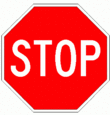 |
 |
 |
 |
 |

|
| Additional Information |
| How Speed Limits are Established |
903.5.1 Application (MUTCD Section 2B.01)
Standard. Regulatory signs shall be used to inform road users of selected traffic laws or regulations and indicate the applicability of the legal requirements.
Regulatory signs shall be installed at or near where the regulations apply. The signs shall clearly indicate the requirements imposed by the regulations and shall be designed and installed to provide adequate visibility and legibility in order to obtain compliance.
Regulatory signs shall be retroreflective or illuminated (see EPG 903.2.17, Retroreflectivity and Illumination) to show the same shape and similar color by both day and night, unless specifically stated otherwise in the text discussion of this article for a particular sign or group of signs.
The requirements for sign illumination shall not be considered to be satisfied by street or highway lighting.
903.5.2 Design (MUTCD Section 2B.02)
Standard. Regulatory signs shall be rectangular unless specifically designated otherwise. Regulatory signs shall be designed in accordance with the sizes, shapes, colors and legends contained in the EPG.
Option. Regulatory word message signs other than those classified and specified in the EPG and the Standard Highway Signs and Markings book may be developed to aid the enforcement of other law or regulations.
Except for symbols on regulatory signs, minor modifications may be made to the design provided that the essential appearance characteristics are met.
Support. The use of educational plaques to supplement symbol signs is described in EPG 903.2.14, Symbols.
Guidance. Changeable Message signs displaying a regulatory message incorporating a prohibitory message that includes a red circle and slash on a static sign should display a red symbol that approximates the same red circle and slash as closely as possible.
903.5.3 Dimensions (MUTCD Section 2B.03)
Standard. Except as provided in EPG 903.2.13, the sizes for regulatory signs shall be as shown in Table 903.5.3, below.
Support. EPG 903.2.13 contains information regarding the applicability of the various columns in Table 903.5.3.
Standard. The minimum sizes for regulatory signs facing traffic on multi-lane conventional roads shall be as shown in the multi-lane column of Table 903.5.3.
Standard. A minimum size of 36 in. x 36 inches shall be used for STOP signs that face multi-lane approaches.
Where side roads intersect a multi-lane street or highway that has a speed limit of 45 mph or higher, the minimum size of the STOP signs facing the side road approaches, even if the side road only has one approach lane, shall be 36 in. x 36 inches.
Where side roads intersect a multi-lane street or highway that has a speed limit of 40 mph or lower, the minimum size of the STOP signs facing the side road approaches shall be as shown in the single lane or multi-lane columns of Table 903.5.3 based on the number of approach lanes on the side street approach.
Table 903.5.3 Regulatory Sign and Plaque Sizes
| Sign or Plaque | Sign Designation | EPG Article | Conventional Road (in. x in.) | Freeway/Expressway (in. x in.) | ||
|---|---|---|---|---|---|---|
| Single Lane | Multi-Lane | Oversized | Mainline and Ramps | |||
| STOP | R1-1 | 903.5.4 | 36 X 36 | 36 X 36 | 48 X 48 | 48 X 48 |
| ALL-WAY | R1-3P | 903.5.4 | 30 X 12 | 30 X 12 | - | - |
| YIELD | R1-2 | 903.5.5 | 48 X 48 | 48 X 48 | - | 60 X 60 |
| TO ONCOMING TRAFFIC | R1-2aP | 903.5.5 | 36 X 30 | 36 X 30 | - | - |
| YIELD HERE TO PEDS | R1-5 | 903.5.6 | 36 X 36 | 36 X 36 | - | - |
| SPEED LIMIT | R2-1 | 903.5.7 | 36 X 48 | 36 X 48 | 48 X 60 | 48 X 60 |
| COMBINED SPEED LIMIT | R2-4a | 903.5.8 | - | - | - | 48 X 96 |
| SPEED LIMIT _ EXCEPT WHERE POSTED | R2-5d | 903.5.9 | 36 X 48 | 36 X 48 | - | 36 X 48 |
| No Right Turn | R3-1 | 903.5.11 | 24 X 24 | 36 X 36 | 48 X 48 | 48 X 48 |
| No Left Turn | R3-2 | 903.5.11 | 24 X 24 | 36 X 36 | 48 X 48 | 48 X 48 |
| NO TURNS | R3-3 | 903.5.11 | 24 X 24 | 36 X 36 | - | 36 X 36 |
| No U Turn | R3-4 | 903.5.11 | 24 X 24 | 48 X 48 | - | - |
| No U Turn/No Left Turn | R3-18 | 903.5.11 | 24 X 24 | 48 X 48 | - | - |
| Right (Left/Ahead) Only | R3-5 | 903.5.13 | 30 X 36 | 30 X 36 | - | - |
| RIGHT (LEFT) LANE MUST TURN RIGHT (LEFT) | R3-7 | 903.5.13 | 30 X 30 | 36 X 36 | - | - |
| Straight and Right (Left) | R3-6 | 903.5.14 | 30 X 36 | 30 X 36 | - | - |
| Two-Way Left Turn Only (overhead) | R3-9a | 903.5.15 | 30 X 36 | 30 X 36 | - | - |
| Center Lane Two-Way Left Turn Only (post-mounted) | R3-9b | 903.5.15 | 24 X 36 | 24 X 36 | 36 X 48 | - |
| DO NOT PASS | R4-1 | 903.5.16 | 36 X 48 | 36 X 48 | - | - |
| PASS WITH CARE | R4-2 | 903.5.17 | 36 X 48 | 36 X 48 | - | - |
| SLOWER TRAFFIC KEEP RIGHT | R4-3 | 903.5.18 | 36 X 48 | 36 X 48 | 48 X 60 | 48 X 60 |
| Keep Right | R4-7 | 903.5.19 | 24 X 30 | 24 X 30 | 36 X 48 | 48 X 60 |
| KEEP RIGHT (horizontal arrow) | R4-7a | 903.5.19 | 36 X 48 | 48 X 60 | 48 X 60 | 48 X 60 |
| KEEP RIGHT (45° arrow) | R4-7b | 903.5.19 | 36 X 48 | 48 X 60 | 48 X 60 | 84 X 96 |
| Keep Left | R4-8 | 903.5.19 | 24 X 30 | 24 X 30 | 36 X 48 | 48 X 60 |
| KEEP LEFT (horizontal arrow) | R4-8a | 903.5.19 | 36 X 48 | 48 X 60 | 48 X 60 | 48 X 60 |
| DO NOT DRIVE ON SHOULDER | R4-17 | 903.5.34 | 36 X 48 | 36 X 48 | - | - |
| DO NOT ENTER | R5-1 | 903.5.20 | 30 X 30 | 36 X 36 | - | 48 X 48 |
| WRONG WAY | R5-1a | 903.5.21 | 36 X 24 | 42 X 30 | 42 X 30 | 42 X 30 |
| PEDESTRIANS PROHIBITED | R5-10c | 903.5.22 | 24 X 12 | 24 X 12 | - | 24 X 12 |
| NO MOTOR VEHICLES | R5-3 | 903.5.22 | 24 X 24 | 24 X 24 | - | 24 X 24 |
| NO VENDING | R5-24 | 903.5.22 | 24 X 24 | 24 X 24 | - | 24 X 24 |
| NO FISHING FROM BRIDGE | R5-25 | 903.5.22 | 18 X 24 | 18 X 24 | - | 18 X 24 |
| NO PARKING ON BRIDGE | R7-35 | 903.5.22 | 18 X 24 | 18 X 24 | - | 18 X 24 |
| DO NOT STOP ON TRACKS | R5-31 | 903.5.22 | 24 X 30 | 24 X 30 | - | - |
| ONE WAY | R6-1 | 903.5.23 | 36 X 12 | 54 X 18 | - | 54 X 18 |
| ONE WAY | R6-2 | 903.5.23 | 24 X 30 | 30 X 36 | - | 48 X 60 |
| DIVIDED HIGHWAY (4-legged) | R6-3 | 903.5.25 | 30 X 24 | 30 X 24 | - | 36 X 30 |
| DIVIDED HIGHWAY (T-intersection) | R6-3a | 903.5.25 | 30 X 24 | 30 X 24 | - | 36 X 30 |
| No Parking Signs | R7 series | 903.5.26 | 18 x 24 | 18 x 24 | - | - |
| Combination No Parking | R7-200 | 903.5.26 | 36 X 24 | 36 X 24 | - | - |
| TOW AWAY ZONE | R7-201aP | 903.5.26 | 18 x 9 | 18 x 9 | - | - |
| NO PARKING TRUCKS AND TRAILERS OVER 6 TONS | R7-36 | 903.5.27 | 18 X 24 | 18 X 24 | - | - |
| RESERVED PARKING | R7-8 | 903.5.28 | 18 X 24 | 18 X 24 | - | - |
| VAN ACCESSIBLE | R7-8P | 903.5.28 | 18 X 9 | 18 X 9 | - | - |
| EMERGENCY STOPPING ONLY | R8-7 | 903.5.29 | 48 X 36 | 48 X 36 | - | 48 X 36 |
| RIGHT TURN SIGNAL | R10-10R | 903.5.30 | 30 X 36 | 30 X 36 | - | - |
| NO TURN ON RED | R10-11a | 903.5.30 | 30 X 36 | 36 X 48 | - | - |
| NO TURN ON RED | R10-11b | 903.5.30 | 36 X 36 | 36 X 36 | - | - |
| EMERGENCY SIGNAL | R10-13 | 903.5.30 | 36 X 24 | 36 X 24 | - | - |
| Turning Vehicles Yield to Pedestrians | R10-15 | 903.5.30 | 30 X 30 | 30 X 30 | - | - |
| Pedestrian Signal Series | R10-3 & R10-4 series | 903.5.30 | 9 X 15 | 9 X 15 | - | - |
| STOP HERE ON RED | R10-6 | 903.5.30 | 24 X 36 | 24 X 36 | - | - |
| DO NOT BLOCK INTERSECTION | R10-7 | 903.5.30 | 24 X 30 | 24 X 30 | - | - |
| DO NOT BLOCK ENTRANCE | R10-7a | 903.5.30 | 24 X 30 | 24 X 30 | - | - |
| TRAFFIC LAW PHOTO ENFORCED | R10-18 | 903.5.31 | 36 X 24 | 36 X 24 | - | - |
| Traffic Signal PHOTO ENFORCED | R10-18a | 903.5.31 | 30 X 42 | 30 X 42 | - | 30 X 42 |
| INCLUDES RIGHT TURN Plaque | R10-18aP | 903.5.31 | 30 X 10 | 30 X 18 | - | 30 X 18 |
| PHOTO ENFORCED | R10-19aP | 903.5.31 | 24 X 18 | 24 X 18 | - | - |
| RIGHT TURN MUST YIELD TO U-TURN | R10-30 | 903.5.30 | 30 X 36 | 30 X 36 | - | - |
| KEEP OFF MEDIAN | R11-1 | 903.5.32 | 36 X 48 | 48 X 60 | 48 X 60 | - |
| ROAD CLOSED | R11-2 | 903.5.33 | 48 X 30 | 48 X 30 | - | - |
| ROAD CLOSED _ MILES AHEAD LOCAL TRAFFIC ONLY | R11-3a | 903.5.33 | 60 X 30 | - | - | - |
| BRIDGE OUT _ MILES AHEAD LOCAL TRAFFIC ONLY | R11-3b | 903.5.33 | 60 X 30 | - | - | - |
| ROAD CLOSED TO THRU TRAFFIC | R11-4 | 903.5.33 | 60 X 30 | - | - | - |
| Weight Limit Signs | R12 series | 903.5.36 | Varies | Varies | Varies | Varies |
| Weigh Station Signs | R13 series | 903.5.37 | - | Varies | - | Varies |
| AUTHORIZED AND EMERGENCY VEHICLES ONLY | R5-29 | 903.5.39 | - | - | - | 24 X 30 |
| BUCKLE UP IT'S THE LAW | R16-27 | 903.5.40 | 36 X 48 | - | - | - |
| STATE LAW MOVE OVER OR SLOW DOWN FOR STOPPED EMERGENCY VEHICLES | R16-25 | 903.5.41 | - | 120 X 60 | - | 120 X 60 |
| HEADLIGHTS ON WHEN WIPERS ARE REQUIRED | R16-5a | 903.5.42 | - | 42 X 36 | - | 42 X 36 |
| Noise Ordinance | R5-21 | 903.5.43 | 30 X 24 | 30 X 24 | 36 X 30 | 36 X 30 |
| No More Trash | R5-26 | 903.5.44 | - | - | - | 30 X 42 |
| NO DUMPING | R5-28 | 903.5.44 | - | - | - | 48 X 24 |
| Roadside Park Signs | R20-1 | 903.5.45 | 30 X 30 | - | - | - |
| Rest Area Signs | R20 series | 903.5.46 | - | - | - | Varies |
| NEXT PASSING LANE _ MILES | R4-28 | 903.5.47 | 36 X 48 | - | - | - |
| END PASSING LANES | R4-29 | 903.5.47 | 36 X 36 | - | - | - |
| TRUCKS AND BUSES MUST MAINTAIN 300 FT. | R4-30 | 903.5.49 | - | - | - | 42 X 30 |
| FINES DOUBLED ENDS | R2-20 | 903.5.50 | - | 36 X 30 | - | 36 X 30 |
903.5.4 STOP Sign (R1-1) and ALL WAY Plaque (R1-3P) (MUTCD Section 2B.05)
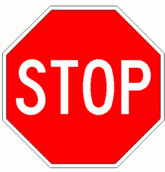 |
Standard. When it is determined that a full stop is always required on an approach to an intersection, a STOP (R1-1) sign shall be used. The STOP sign shall be an octagon with a white legend and border on a red background. Secondary legends shall not be used on STOP sign faces.
At intersections where all approaches are controlled by STOP signs (see EPG 903.5.4.3), an ALL-WAY supplemental plaque (R1-3P) shall be mounted below each STOP sign. The ALL WAY plaque (R1-3P) shall have a white legend and border on a red background.
The ALL WAY plaque shall only be used if all intersection approaches are controlled by STOP signs.
Supplemental plaques with legends such as 2-WAY, 3-WAY, 4-WAY, or other numbers of ways shall not be used with STOP signs.
Guidance. Plaques with the appropriate alternative messages of TRAFFIC FROM LEFT (RIGHT) DOES NOT STOP (W4-4aP) or ONCOMING TRAFFIC DOES NOT STOP (W4-4bP) should be used at intersections where STOP signs control all but one approach to the intersection, unless the only non-stopped approach is from a one-way street, see EPG 903.6.49.
Option. When engineering judgment indicates that conditions are present that are causing or could cause drivers to misinterpret the intersection as an all-way stop, the W4-4P series of signs may be displayed below the STOP sign, see EPG 903.6.49.
Support. The design and application of Stop Beacons are described in EPG 902.
903.5.4.1 STOP Sign Applications (MUTCD Section 2B.06)
Guidance. STOP signs should be used if engineering judgment indicates that one or more of the following conditions exist:
A. Intersection of a less important road with a main road where application of the normal right of way rule would not be expected to provide reasonable compliance with the law;
B. Street entering a through highway or street;
C. Unsignalized intersection in a signalized area; and/or
D. High speeds, restricted view, or crash records indicate a need for control by the STOP sign.
Guidance. Public and significant private road approaches to the state system shall have a STOP or YIELD (R1-2) sign installed. Significant private roads are those that have 3 or more private residences.
Because the potential for conflicting commands could create driver confusion, STOP signs shall not be installed at intersections where traffic control signals are installed and operating except in the following cases:
A. If the signal indication for an approach is a flashing red at all times;
B. If a minor street or driveway is located within or adjacent to the area controlled by the traffic control signal, but does not require separate traffic signal control because an extremely low potential for conflict exists; or
C. If a channelized turn lane is separated from the adjacent travel lanes by an island and the channelized turn lane is not controlled by a traffic control signal.
Except as provided in EPG 903.5.5.1, STOP signs and YIELD signs shall not be installed on different approaches to the same unsignalized intersection if those approaches conflict with or oppose each other.
Portable or part-time STOP signs shall not be used except for emergency and temporary traffic control zone purposes.
A portable or part-time (folding) STOP sign that is manually placed into view and manually removed from view shall not be used during a power outage to control a signalized approach unless the maintaining agency establishes that the signal indication that will first be displayed to that approach upon restoration of power is a flashing red signal indication and that the portable STOP sign will be manually removed from view prior to stop-and-go operation of the traffic control signal.
Guidance. STOP signs should not be used for speed control.
At intersections where a full stop is not necessary at all times, consideration should be given to using less restrictive measures such as YIELD signs (see EPG 903.5.5 YIELD Sign).
Once the decision has been made to install two-way stop control, the decision regarding the appropriate street to stop should be based on engineering judgment. In most cases, the street carrying the lowest volume of traffic should be stopped.
A STOP sign is not to be installed on the major street unless justified by a traffic engineering study.
Support. The following are considerations that might influence the decision regarding the appropriate street upon which to install a STOP sign where two streets with relatively equal volumes and/or characteristics intersect:
A. Stopping the direction that conflicts the most with established pedestrian crossing activity or school walking routes;
B. Stopping the direction that has obscured vision, dips, or bumps that already require drivers to use lower operating speeds;
C. Stopping the direction that has the longest distance of uninterrupted flow approaching the intersection; and
D. Stopping the direction that has the best sight distance to conflicting traffic.
The use of the STOP sign at grade crossings is described in EPG 903.20.
Option. Upon request of a resident of a minor private road approach, a STOP or YIELD sign may be installed. STOP or YIELD signs may be installed at any private or commercial entrance based on engineering judgment or traffic studies.
903.5.4.2 STOP Sign Placement (MUTCD Section 2B.10)
Standard. The STOP sign shall be installed on the near side of the intersection on the right-hand side of the approach to which it applies. When the STOP sign is installed at this required location and the sign visibility is restricted, a Stop Ahead sign (see EPG 903.6.28 Advance Traffic Control Signs) shall be installed in advance of the STOP sign.
The STOP sign shall be located as close as practical to the intersection it regulates, while optimizing its visibility to the road user it is intended to regulate.
STOP signs and YIELD signs shall not be mounted on the same post.
No items other than inventory stickers, sign installation dates, and bar codes shall be affixed to the fronts of the STOP signs, and the placement of these items shall be in the border of the sign.
No items other than official traffic control signs, inventory stickers, sign installation dates, anti-vandalism stickers, and bar codes shall be mounted on the backs of STOP signs.
No items other than retroreflective strips or official traffic control signs shall be mounted on the fronts or backs of STOP sign supports.
Guidance. A sign that is mounted back-to-back with a STOP sign should stay within the edges of the STOP sign. If necessary, the size of the STOP sign should be increased so that any other sign installed back to back with a STOP sign remains within the edges of the STOP sign.
Support. EPG 903.2.18 Standardization of Sign Location contains additional information about separate and combined mounting of other signs with STOP signs.
Guidance. Stop lines, that are used to supplement a STOP sign, should be located as described in EPG 620 Pavement Marking.
Where there is a marked crosswalk at the intersection, the STOP sign should be installed in advance of the crosswalk line nearest to the approaching traffic.
If only one STOP sign is installed on an approach, the STOP sign should not be placed on the far side of the intersection.
Where two roads intersect at an acute angle, the STOP sign should be positioned at an angle, or shielded, so that the legend is out of view of traffic to which it does not apply. Where there is a marked crosswalk at the intersection, the STOP sign should be installed in advance of the crosswalk line nearest to the approaching traffic.
Option. At wide-throat intersections or where two or more approach lanes of traffic exist on the signed approach, observance of the stop control may be improved by the installation of an additional STOP sign on the left-hand side of the road and/or the use of a stop line. At channelized intersections or at divided roadways separated by a median, the additional STOP sign may be placed on a channelizing island or in the median. An additional STOP sign may also be placed overhead facing the approach at the intersection to improve observance of the right of way control.
Support. Fig. 903.2.18.2 shows examples of some typical placements of STOP signs.
Standard. More than one STOP sign shall not be placed on the same support facing the same direction.
903.5.4.3 Multiway Stop Applications (MUTCD Section 2B.07)
Support. Multiway stop control can be useful as a safety measure at intersections if certain traffic conditions exist. Safety concerns associated with multiway stops include pedestrians, bicyclists, and all road users expecting other road users to stop. Multiway stop control is used where the volume of traffic on the intersecting roads is approximately equal.
The restrictions on the use of STOP signs described in EPG 903.5.4.1 also apply to multiway stop applications.
Guidance. The decision to install multiway stop control should be based on an engineering study. The following criteria should be considered in the engineering study for a multiway STOP sign installation:
A. Where traffic control signals are justified, the multiway stop is an interim measure that can be installed quickly to control traffic while arrangements are being made for the installation of the traffic control signal.
B. Five or more reported crashes in a 12-month period that are susceptible to correction by a multiway stop installation. Such crashes include right- and left-turn collisions as well as right-angle collisions.
C. Minimum volumes:
- 1. The vehicular volume entering the intersection from the major street approaches (total of both approaches) averages at least 300 vehicles per hour for any 8 hours of an average day, and
- 2. The combined vehicular, pedestrian, and bicycle volume entering the intersection from the minor street approaches (total of both approaches) averages at least 200 units per hour for the same 8 hours, with an average delay to minor-street vehicular traffic of at least 30 seconds per vehicle during the highest hour, but
- 3. If the 85th-percentile approach speed of the major-street traffic exceeds 40 mph, the minimum vehicular volume warrants are 70 percent of the values in Items 1 and 2, above.
D. Where no single criterion is satisfied, but where Criteria B, C.1, and C.2 are all satisfied to 80 percent of the minimum values. Criterion C.3 is excluded from this condition.
Option. Other criteria that may be considered in an engineering study include:
A. The need to control left-turn conflicts;
B. The need to control vehicle/pedestrian conflicts near locations that generate high pedestrian volumes;
C. Locations where a road user, after stopping, cannot see conflicting traffic and is not able to negotiate the intersection unless conflicting cross traffic is also required to stop; and
D. An intersection of two residential neighborhood collector (through) streets of similar design and operating characteristics where multiway stop control would improve traffic operational characteristics of the intersection.
903.5.5 YIELD Sign (R1-2, R1-2a) (MUTCD Section 2B.08)
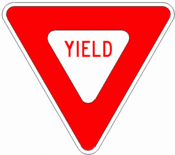 |
 |
Standard. The YIELD (R1-2) sign shall be a downward-pointing equilateral triangle with a wide red border and the legend YIELD in red on a white background.
Support. The YIELD sign assigns right-of-way to traffic on certain approaches to an intersection. Vehicles controlled by a YIELD sign need to slow down to a speed that is reasonable for the existing conditions or stop when necessary to avoid interfering with conflicting traffic.
Standard. The TO ONCOMING TRAFFIC (R1-2a) plaque shall be used to supplement the YIELD sign before one-lane bridges. Refer to Figs. 903.5.36.3 and 903.5.36.4 in EPG 903.5.36.1 Weight/Speed Restriction Signing.
903.5.5.1 YIELD Sign Applications (MUTCD Section 2B.09)
Option. YIELD signs may be installed:
A. On the approaches to a through street or highway where conditions are such that a full stop is not always required.
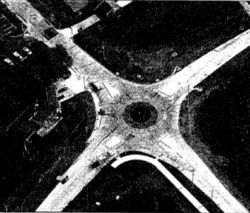
B. For a channelized turn lane that is separated from the adjacent travel lanes by an island, even if the adjacent lanes at the intersection are controlled by a highway traffic control signal or by a STOP sign.
C. At the second crossroad of a divided highway, where the median width at the intersection is 30 ft. or greater. In this case, a STOP or YIELD sign may be installed at the entrance to the first roadway of a divided highway and a YIELD sign may be installed at the entrance to the second roadway.
D. An intersection where a special problem exists and where engineering judgment indicates the problem to be susceptible to correction by the use of the YIELD sign.
E. Facing the entering roadway for a merge-type movement if engineering judgment indicates that control is needed because acceleration geometry and/or sight distance is not adequate for merging traffic operation. (See EPG 903.16.23 Location of Yield and Lane Ends Sign for Acceleration Ramps for additional information.)
Standard. A YIELD (R1-2) sign shall be used to assign right of way at the entrance to a roundabout. YIELD signs at roundabouts shall be used to control the approach roadways and shall not be used to control the circulatory roadway. Other than for all of the approaches to a roundabout, YIELD signs shall not be placed on all of the approaches to an intersection.
903.5.5.2 YIELD Sign Placement (MUTCD Section 2B.10)
Standard. The YIELD sign shall be installed on the near side of the intersection on the right-hand side of the approach to which it applies. When the YIELD sign is installed at this required location and the sign visibility is restricted, a YIELD AHEAD sign (see EPG 903.6.28) shall be installed in advance of the YIELD sign.
The YIELD sign shall be located as close as practical to the intersection it regulates, while optimizing its visibility to the road user it is intended to regulate.
YIELD signs shall not be mounted on the same post.
No items other than inventory stickers, sign installation dates, and bar codes shall be affixed to the fronts of YIELD signs, and the placement of these items shall be in the border of the sign. No items other than official traffic control signs, inventory stickers, sign installation dates, anti-vandalism stickers, and bar codes shall be mounted on the backs of YIELD signs. No items other than retroreflective strips or official traffic control signs shall be mounted on the fronts or backs of YIELD sign supports.
YIELD signs shall not be used on Freeways and Expressways where there is more than 600 ft. of an acceleration lane, measured from the outside ramp curve point at the beginning of the acceleration lane to the end of the taper. When used on Freeways and Expressways, a 60-in. YIELD (R1-2) sign shall be used.
YIELD signs shall be used at a cloverleaf interchange where the in-loop traffic merges with the acceleration and deceleration traffic movement. In these cases, a 60-in. YIELD (R1-2) sign shall be utilized.
Guidance. A sign that is mounted back-to-back with a YIELD sign should stay within the edges of the YIELD sign, see EPG 903.5.30 for proper sign sizes.
Support. Location Standardization, EPG 903.2.18, contains additional information about separate and combined mounting of other signs with YIELD signs.
Guidance. Yield lines, when used to supplement a YIELD sign, should be located at a point where the road user should yield (see EPG 620 Pavement Marking).
Where two roads intersect at an acute angle, the YIELD sign should be positioned at an angle, or shielded, so that the legend is out of view of traffic to which it does not apply.
Except at roundabout intersections, where there is a marked crosswalk at the intersection, the YIELD sign should be installed in advance of the crosswalk line nearest to the approaching traffic.
At a roundabout intersection, to prevent circulating vehicles from yielding unnecessarily, the face of the YIELD sign is not to be visible from the circulatory roadway.
YIELD signs should be used where an island, either painted or physical, creates free movements.
Option. YIELD signs may also be used without an island, such as an acceleration ramp.
At wide-throat intersections or where two or more approach lanes of traffic exist on the signed approach, observance of the yield control may be improved by the installation of an additional YIELD sign on the left side of the road and/or the use of a yield line. At channelized intersections, the additional YIELD sign may be effectively placed on a channelizing island.
903.5.6 YIELD HERE TO PEDESTRIANS Signs (R1-5, R1-5a) (MUTCD Section 2B.11)
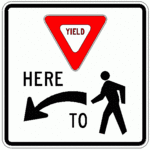 |
 |
Standard. Yield Here To Pedestrians (R1-5, R1-5a) signs shall be used if yield lines are used in advance of a marked crosswalk that crosses an uncontrolled multi-lane approach.
Guidance. If Yield lines and Yield Here To Pedestrians (R1-5 or R1-5a) signs are used in advance of a crosswalk that crosses an uncontrolled multi-lane approach, they should be placed 20 to 50 ft. in advance of the nearest crosswalk line (see EPG 620 Pavement Marking) and parking should be prohibited in the area between the yield line and the crosswalk.
Standard. If a W11-2 Pedestrian Warning sign has been post-mounted at the crosswalk location where a Yield Here to Pedestrians sign is used on the approach, the Yield Here to Pedestrians sign shall not be placed on the same post as or block the road user’s view of the W11-2 sign.
Support. The Yield Here To Pedestrians (R1-5, R1-5a) sign can be positioned for right-hand and left-hand indications.
903.5.7 SPEED LIMIT Sign (R2-1) (MUTCD Section 2B.13)
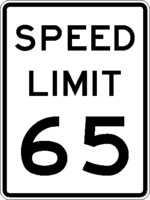
Standard. Speed limits shall be as established by or in accordance to Missouri Statute 304.010.
After an engineering study has been made according to established traffic engineering practices, the SPEED LIMIT (R2-1) sign shall display the limit established by law, ordinance, regulation, or as adopted by the authorized agency. The speed limits shown shall be in multiples of 5 mph.
Guidance. No more than three speed limits should be displayed on any one Speed Limit sign or assembly. When a speed limit should be posted, it should be within 5 mph of the 85th-percentile speed of free-flowing traffic. Speed studies for signalized intersection approaches should be taken outside the influence area of the traffic control signal, which is generally considered to be approximately ½ mile, to avoid obtaining skewed results for the 85th-percentile speed.
A Reduced Speed Limit Ahead (W3-5 or W3-5a) sign should be used to inform road users of a reduced speed zone where the speed limit is being reduced by more than 10 mph, or where engineering judgment indicates the need for advance notice to comply with the posted speed limit ahead.
Option. Other factors that may be considered when establishing speed limits (see EPG 949.2) are the following:
A. Road characteristics, shoulder condition, grade, alignment, and sight distance;
B. The pace speed;
C. Roadside development and environment;
D. Parking practices and pedestrian activity; and
E. Reported crash experience for at least a 12-month period.
A Changeable Message sign that changes the speed limit for traffic and ambient conditions may be installed provided that the appropriate speed limit is shown at the proper times.
A Changeable Message sign that displays to approaching drivers the speed at which they are traveling may be installed in conjunction with a Speed Limit sign.
Guidance. If a Changeable Message sign displaying approach speeds is installed, the legend YOUR SPEED XX MPH or such similar legend should be shown. The color of the changeable message legend should be a yellow legend on a black background or the reverse of these colors.
An advisory speed plaque mounted below a warning sign should be used to warn road users of an advisory speed for a roadway condition. A Speed Limit sign should not be used for this situation.
Support. Advisory Speed signs are discussed in EPG 903.6.36 and EPG 903.6.46 and Temporary Traffic Control Zone Speed signs are discussed in the MoDOT Traffic Control for Field Operations.
903.5.8 Combination Speed Limit Sign (R2-4a)

Standard. A Combination Speed Limit (R2-4a) sign shall be posted in urban areas and at each county line and only on Interstate routes.
Option. Where engineering judgment determines that slow speeds on a highway might impede the normal and reasonable movement of traffic, the Combination Speed Limit sign may be installed to indicate the minimum legal speed.
903.5.9 SPEED LIMIT XX EXCEPT WHERE POSTED Signs (R2-5d)

Standard. The Speed Limit XX Except Where Posted (R2-5d) sign shall be authorized only at those locations where it has been requested and required by an enabling ordinance.
Guidance. The Speed Limit XX Except Where Posted sign should be placed immediately to the right of the City Limit sign on its own post.
Option. The Speed Limit XX Except Where Posted sign may be used on all state highways and outer roads except the Interstate system.
903.5.10 Location of Speed Limit Signs
Standard. Speed Limit (R2-1) signs, indicating speed limits for which posting is required by law, shall be located at the points of change from one speed limit to another.
At the end of the section to which a speed limit applies, a Speed Limit sign showing the next speed limit shall be installed. Additional Speed Limit signs shall be installed beyond major intersections and at other locations where it is necessary to remind road users of the speed limit that is applicable.
Speed Limit signs indicating the statutory speed limits shall be installed at entrances to Missouri and at jurisdictional boundaries of metropolitan areas.
Guidance. Care should be taken to ensure Speed Limit signs are not located at curves or other points where the legal speed limit is greater than the safe speed. If speed limit signs are installed on the same sign supports and over a city limit sign, the sign supports should be sized to properly support both signs.
The following are recommended locations for posting a Speed Limit sign:
A. Downstream from all acceleration ramps on the freeway/expressway system, posted after the route confirmation marker, if space allows;
B. Downstream from major intersections such as state system junctions, signalized intersections, and major county road junctions;
C. Where it is necessary to remind road users of the speed limit that is applicable;
D. In each direction of travel for motorist leaving the Interstate system onto a state route. The sign should be located, if practical, approximately 400 ft. beyond the route confirmation assembly. If the crossroad is not located on the state system, the proper jurisdiction should be notified; or
E. When the speed limit is reduced on the freeway/expressway, an additional sign should be posted in the median.
903.5.11 Movement Prohibition Signs (R3-1 through R3-4 and R3-18) (MUTCD Section 2B.18)
 |
 |
 |
 |
 |
Standard. Except as provided in the Option and the No U-Turn sign (R3-4) guidance, where movements are prohibited, Movement Prohibition signs shall be installed. Missouri Statute 304.341, which governs U-turn Movements, states:
- It shall be unlawful for the driver of any vehicle to turn such vehicle so as to proceed in the opposite direction at any intersection controlled by a traffic signal or police officer; nor shall such turn be made at any place unless the movement can be made in safety and without interfering with other traffic.
Missouri Statute 304.120 allows municipalities, by ordinance, to make additional rules of the road or traffic regulations to meet their needs and traffic conditions, which would allow U-turn Movements if needed.
The No U-Turn sign (R3-4) shall be used sparingly and only where a specific problem has been documented and not as standard practice for median breaks. If used, these signs shall be placed at or between intersections to indicate where U-turns are prohibited.
The No U-Turn sign shall be installed in conjunction with the Authorized and Emergency Vehicle Only sign (R5-19). The No U-Turn sign shall be installed above the Authorized Emergency Vehicle Only sign. See the Authorized and Emergency Vehicle Only sign, for additional information.
Guidance. Movement Prohibition signs should be placed where they will be most easily seen by road users who might be intending to make the movement.
If No Right Turn (R3-1) signs are used, at least one should be placed either over the roadway or at a right-hand corner of the intersection.
If No Left Turn (R3-2) signs are used, at least one should be placed either over the roadway, at the far left-hand corner of the intersection, on a median, or in conjunction with the STOP sign or YIELD sign located on the near right corner.
Except as provided in the Option, if NO TURNS (R3-3) signs are used, two signs should be used, one at a location specified for a No Right Turn sign and one at a location specified for a No Left Turn sign.
If No U-Turn (R3-4) signs or combination No U-Turn/No Left Turn (R3-18) signs are used, at least one should be used at a location specified for No Left Turn signs.
Option. If both left turns and U-turns are prohibited, the combination No U-Turn/No Left Turn (R3-18) sign may be used instead of separate R3-2 and R3-4 signs.
Guidance. If No Straight Through (R3-27) signs are used, at least one should be placed either over the roadway or at a location where it can be seen by road users who might be intending to travel straight through the intersection.
If signals are present:
A. The No Right Turn sign should be installed adjacent to a signal face viewed by road users in the right-hand lane.
B. The No Left Turn (or No U-Turn or combination No U-Turn/No Left Turn) sign should be installed adjacent to a signal face viewed by road users in the left lane.
C. A NO TURNS sign should be placed adjacent to a signal face viewed by all road users on that approach, or two signs should be used.
If turn prohibition signs are installed in conjunction with traffic control signals, an additional Movement Prohibition sign may be post-mounted to supplement the sign mounted overhead.
Where ONE WAY signs are used (see EPG 903.5.23), No Left Turn and No Right Turn signs may be omitted.
When the movement restriction applies during certain time periods only, the following Movement Prohibition signing alternatives may be used and are listed in order of preference:
A. Changeable Message signs (Blank Out signs), especially at signalized intersections.
B. Permanently mounted signs incorporating a supplementary legend showing the hours and days during which the prohibition is applicable.
C. Portable signs, installed by proper authority, located off the roadway at each corner of the intersection. The portable signs are only to be used during the time that the movement prohibition is applicable.
Movement Prohibition signs may be omitted at a ramp entrance to an expressway or a channelized intersection where the design is such as to indicate clearly the one-way traffic movement on the ramp or turning lane.
Standard. The No Left Turn (R3-2) sign, the No U-Turn (R3-4) sign, and the combination No U-Turn/No Left Turn (R3-18) sign shall not be used at approaches to roundabouts to prohibit drivers from turning left onto the circulatory roadway of a roundabout.
Support. At roundabouts, the use of R3-2, R3-4, or R3-18 signs to prohibit left turns onto the circulatory roadway might confuse drivers about the possible legal turning movements around the roundabout. Roundabout Directional Arrow (R6-4 series) signs and/or ONE WAY (R6-1R or R6-2R) signs are the appropriate signs to indicate the travel direction within a roundabout.
903.5.12 Intersection Lane Control Signs (R3-5 through R3-8) (MUTCD Section 2B.19)
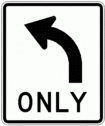 |
 |
 |
 |
 |
 |
 |
Standard. Intersection Lane Control signs, if used, shall require road users in certain lanes to turn, shall permit turns from a lane where such turns would otherwise not be permitted, shall require a road user to stay in the same lane and proceed straight through an intersection, or shall indicate permitted movements from a lane. Intersection Lane Control signs shall have three applications:
A. Mandatory Movement Lane Control (R3-5, R3-5a, and R3-7) signs;
B. Optional Movement Lane Control (R3-6) sign; and
C. Advance Intersection Lane Control (R3-8 series) signs.
Intersection Lane Control signs shall not be used in lieu of turn prohibition signs, such as No Right-Turn (R3-1).
The Left Only (R3-5L) sign shall be installed on the back side of the mast arms over the left turn lanes where practical.
Lane Control signs shall not be installed on the far side of the intersection.
Guidance. Lane Control signs should be mounted overhead approximately 250 ft. in advance of the stop bar. These signs should be used for ramps with two or more lanes approaching the ramp intersection, or approaches to intersections with high approach volumes, or unusual or unexpected geometrics. A one-arm cantilever tubular truss to support these signs should be used to eliminate an obstacle on one side of the roadway.
When Intersection Lane Control signs are mounted overhead, each sign should be placed over the lane or a projection of the lane to which it applies.
On signalized approaches where through lanes that become mandatory turn lanes, multiple-lane turns that include shared lanes for through and turning movements, or other lane-use regulations are present, overhead lane control signs should be installed at the signalized location over the appropriate lanes or projections thereof and in advance of the intersection over the appropriate lanes.
Where overhead mounting on the approach is impractical for the advance and/or intersection lane-use signs, one of the following alternatives should be employed:
A. At locations where through lanes become mandatory turn lanes, a mandatory movement lane control (R3-7) sign should be post-mounted on the left-hand side of the roadway where a through lane is becoming a mandatory left-turn lane on a one-way street or where a median of sufficient width for the signs is available, or on the right-hand side of the roadway where a through lane is becoming a mandatory right-turn lane.
B. At locations where a through lane is becoming a mandatory left-turn lane on a two-way street where a median of sufficient width for the signs is not available, and at locations where multiple-lane turns that include shared lanes for through and turning movements are present, an Advance Intersection Lane Control (R3-8 series) sign should be post-mounted in a prominent location in advance of the intersection, and consideration should be given to the use of an oversized version in accordance with Table 903.5.3.
Standard. Use of an overhead sign for one approach lane shall not require installation of overhead signs for the other lanes of that approach.
Option. A signal mast arm design (without signal head) may be used to mount Lane Control signs, which allows a longer arm than standard one or two arm tubular sign supports. The pedestal may be placed on either side of the roadway, and if possible, placed so that roadway geometrics draw traffic away from the pedestal.
Where an approach has one or two through lanes, the Intersection Lane Control signs (R3-5, R3-6, or R3-8) may be overhead or ground mounted. Intersection Lane Control signs may be omitted where:
A. Turning bays have been provided by physical construction or pavement markings, and
B. Only the road users using such turning bays are permitted to make a similar turn.
Standard. Where three or more approach lanes are available to traffic, Advance Intersection Lane Control (R3-8 series) signs, if used, shall be post-mounted in advance of the intersection and shall not be mounted overhead.
Guidance. If used, an Advance Intersection Lane Control sign should be placed at an adequate distance in advance of the intersection so that road users can select the appropriate lane. If used, the Advance Intersection Lane Control sign should be installed either in advance of the tapers or at the beginning of the turn lane.
Option. An Advance Intersection Lane Control sign may be repeated closer to the intersection for additional emphasis.
903.5.13 Mandatory Movement Lane Control Signs (R3-5, R3-5a and R3-7)(MUTCD Section 2B.20)
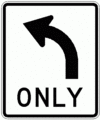 |
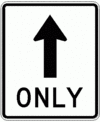 |
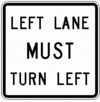 |
Standard. If used, the Mandatory Movement Lane Control (R3-5, R3-5a and R3-7) sign shall indicate only the single vehicle movement that is required from the lane. If used, the Mandatory Movement Lane Control sign shall be located in advance of the intersection, such as near the upstream end of the mandatory movement lane, and/or at the intersection where the regulation applies.
The Mandatory Movement Lane Control (R3-7) sign shall include the legend RIGHT (LEFT) LANE MUST TURN RIGHT (LEFT). The Mandatory Movement Lane Control (R3-5 and R3-5a) symbol signs shall include the legend ONLY.
The R3-7 word message sign shall be for post-mounting only.
The use of the Mandatory Movement Lane Control (R3-7) word message sign shall be limited to only locations that are adjacent to the full-width portion of a mandatory turn lane. The R3-7 sign shall not be installed adjacent to a through lane in advance of a turn bay taper or adjacent to a turn bay taper.
Where the number of lanes available to through traffic on an approach is three or more, Mandatory Movement Lane Control (R3-5 and R3-5a) symbol signs, if used, shall be mounted overhead over the specific lanes to which they apply (see EPG 903.5.12).
Guidance. Mandatory Movement Lane Control signs should be accompanied by lane use arrow markings, especially where traffic volumes are high, where there is a high percentage of commercial vehicles, or where other distractions exist.
If the R3-5 or R3-5a sign is post-mounted on an approach with two or fewer through lanes, an appropriate supplemental plaque should be added above the sign to indicate the specific lane to which the mandatory movement applies.
Option. The Straight Through Only (R3-5a) sign may be used to require a road user in a particular lane to proceed straight through an intersection.
When the Mandatory Movement Lane Control sign for a left-turn lane is installed back-to-back with a Keep Right (R4-7) sign, the dimensions of the Mandatory Movement Lane Control (R3-5) sign may be the same as the Keep Right sign.
903.5.14 Optional Lane Control Sign (R3-6) (MUTCD Section 2B.21)
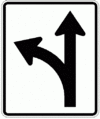
Standard. If used, the Optional Movement Lane Control (R3-6) sign shall be used for two or more movements from a specific lane or to emphasize permitted movements. If used, the Optional Movement Lane Control sign shall be located in advance of the intersection, such as near the upstream end of an adjacent mandatory movement lane, and/or at the intersection where the regulation applies. If used, the Optional Movement Lane Control sign shall indicate all permissible movements from specific lanes.
Optional Movement Lane Control signs shall be used for two or more movements from a specific lane where a movement, not normally allowed, is permitted. The Optional Movement Lane Control sign shall not be used alone to affect a turn prohibition.
Where the number of lanes available to through traffic on an approach is three or more, an Optional Movement Lane Control (R3-6) sign, if used, shall be mounted overhead over the specific lane to which it applies (see EPG 903.5.12).
Because more than one movement is permitted from the lane, the word message ONLY shall not be used on an Optional Movement Lane Control sign.
Option. The word message OK may be used within the border in combination with the arrow symbols of the R3-6 sign.
903.5.15 Two-Way Left Turn Only/Center Lane Only Signs (R3-9a, R3-9b)(MUTCD Section 2B.24)
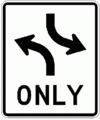 |
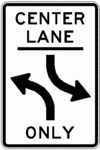 |
Standard. Missouri Statute 300.215, which governs two way left turn lane movements states:
- Designated two-way left turn lanes: Where a special lane for making left turns by drivers proceeding in opposite directions have been indicated by official traffic control devices:
- A. A left turn shall not be made from any other lane;
- B. A vehicle shall not be driven in the lane except when preparing for or making a left turn from or into the roadway or when preparing for or making a u-turn when otherwise permitted by law;
- C. A vehicle shall not be driven in the lane for a distance more than five hundred feet.
Two-Way Left Turn Only (R3-9a) signs shall be used for overhead installation only.
Center Lane Only (R3-9b) signs shall be post mounted installations.
Guidance. Two-Way Left Turn Only and Center Lane Only signs should be used in conjunction with the required pavement markings where a nonreversible lane is reserved for the exclusive use of left-turning vehicles in either direction and is not used for passing, overtaking or through travel.
Option. The ground-mounted R3-9b sign may be used as an alternate to or a supplement to the overhead-mounted R3-9a sign, and additional R3-9b signs may be used based on engineering judgment. The legend BEGIN or END may be used within the border of the main sign itself, or on a plaque mounted immediately above it.
Support. Signing is especially helpful to drivers in areas where the two-way left turn only maneuver is new, in areas subject to environmental conditions that frequently obscure the pavement markings, and on peripheral streets with two-way left turn only lanes leading to an extensive system of routes with two-way left turn only lanes.
903.5.16 DO NOT PASS Sign (R4-1) (MUTCD Section 2B.28)

Option. The DO NOT PASS (R4-1) sign may be used in addition to pavement markings to emphasize the restriction on passing. The DO NOT PASS sign may be used for one-lane bridges and work zones. Any other use of this sign requires authorization from the State Highway Safety and Traffic Engineer.
The DO NOT PASS sign may be used at the beginning of, and at intervals within, a zone through which sight distance is restricted or where other conditions make overtaking and passing inappropriate.
Standard. PASS WITH CARE (R4-2) signs shall be used in conjunction with the DO NOT PASS sign.
Support. Standards for determining the location and extent of no-passing zone pavement markings are set forth in EPG 620.
903.5.17 PASS WITH CARE (R4-2) (MUTCD Section 2B.29)

Guidance. The PASS WITH CARE (R4-2) sign should be installed at the downstream end of a no-passing zone if a DO NOT PASS sign has been installed at the upstream end of the zone.
Standard. The PASS WITH CARE sign shall be the same size and shall be erected in the same manner as the DO NOT PASS (R4-1) sign.
903.5.18 SLOWER TRAFFIC KEEP RIGHT (R4-3) (MUTCD Section 2B.30)
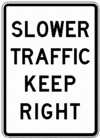
Standard. The SLOWER TRAFFIC KEEP RIGHT (R4-3) sign shall be required for climbing lanes.
Option. The sign may be used on multi-lane roadways to reduce unnecessary lane changing.
Guidance. If used, the SLOWER TRAFFIC KEEP RIGHT sign should be installed just beyond the beginning of a multi-lane pavement, and at selected locations where there is a tendency on the part of some road users to drive in the left lane (or lanes) below the normal speed of traffic. This sign is not to be used on the approach to an interchange or through an interchange area.
903.5.19 KEEP RIGHT AND KEEP LEFT Signs (R4-7, R4-7a, R4-7b, R4-8, R4-8a, R4-8d) (MUTCD Section 2B.32)
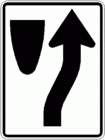 |
 |
 |
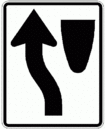 |
 |
Option. The symbolic Keep Right (R4-7) sign may be used at locations where it is necessary for traffic to pass only to the right-hand side of a roadway feature or obstruction. The symbolic Keep Left (R4-8) sign may be used at locations where it is necessary for traffic to pass only to the left-hand side of a roadway feature or obstruction.
Guidance. At locations where it is not readily apparent that traffic is required to keep to the right, a Keep Right sign should be used.
If used, the Keep Right sign should be installed as close as practical to approach ends of raised medians, parkways, islands, and underpass piers. The sign should be mounted on the face of or just in front of a pier or other obstruction separating opposite directions of traffic in the center of the highway so that traffic will have to pass to the right-hand side of the sign.
The KEEP RIGHT (R4-7b) should be erected within 50 ft. of the gore point, if possible. Where pavement transitions from two lanes, two-way roadway to a divided highway, the edge of the sign should be a minimum of 6 ft. from the curb or shoulder point.
Standard. The Keep Right sign (R4-7, R4-7a, R4-7b) shall not be installed on the right-hand side of the roadway in a position where traffic must pass to the left-hand side of the sign.
The KEEP RIGHT (R4-7b) sign shall be erected as near the nose of the median as possible where an undivided highway transitions into a divided highway.
A narrow Keep Right sign shall not be installed on a median island that has a width of 4 ft. or more at the point where the sign is to be located. Supplemental plaques are not supported by MUTCD. KEEP RIGHT signs (R4-8d) have been discontinued. MoDOT shall no longer provide KEEP RIGHT signs (R4-8d). Existing KEEP RIGHT signs (R4-8d) shall be left in place until they reach the end of their service life.
Option. The Keep Right sign may be omitted at intermediate ends of divisional islands and medians. Where the obstruction obscures the Keep Right sign, the minimum placement height may be increased for better sign visibility.
903.5.20 DO NOT ENTER Sign (R5-1) (MUTCD Section 2B.37)
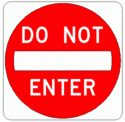
Standard. The DO NOT ENTER (R5-1) sign shall be used where traffic is prohibited from entering a restricted roadway. If the sign is mounted behind a STOP or YIELD sign, the 36-in. DO NOT ENTER sign shall be used behind a 48 in. STOP sign and a 30 in. DO NOT ENTER sign shall be used behind a 60-in. YIELD sign.
Guidance. The DO NOT ENTER sign, if used, should be placed directly in view of a road user at the point where a road user could wrongly enter a divided highway, one-way roadway, or ramp. The sign should be mounted on the right-hand side of the roadway, facing traffic that might enter the roadway or ramp in the wrong direction.
If the DO NOT ENTER sign would be visible to traffic to which it does not apply, the sign should be turned away from, or shielded from, the view of that traffic.
Option. The DO NOT ENTER sign may be installed where it is necessary to emphasize the one-way traffic movement on a ramp or turning lane. A second DO NOT ENTER sign on the left-hand side of the roadway may be used, particularly where traffic approaches from an intersecting roadway.
903.5.21 WRONG WAY Sign (R5-1a) (MUTCD Section 2B.38)

Option. The WRONG WAY (R5-1a) sign may be used as a supplement to the DO NOT ENTER sign where an exit ramp intersects a crossroad or a crossroad intersects a one-way roadway in a manner that does not physically discourage or prevent wrong-way entry. See EPG 903.16 Typical Signing Applications for typical placements of WRONG WAY signs.
Guidance. If used, the WRONG WAY sign should be placed at a location along the exit ramp or the one-way roadway farther from the crossroad than the DO NOT ENTER sign (see EPG 903.5.24).
Option. ONE WAY signs may be omitted at intersections with divided highways that have median widths at the intersection itself of less than 30 feet.
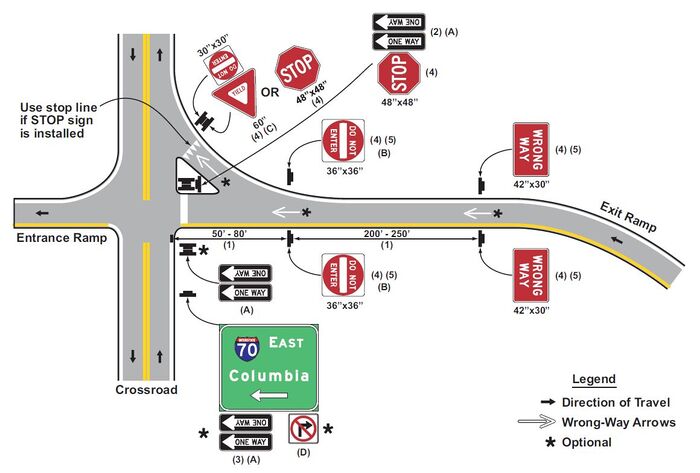
| General Notes: | (1) Distances and offsets may be adjusted based on engineering judgement to avoid blocking visibility of other signs |
| (2) When signals are present, ONE WAY signs may be mounted to signal posts | |
| (3) ONE WAY signs may be installed back to back below crossroad guide signs located <50’ from ramp | |
| (4) 4”x72” red sign post delineators are optional | |
| (5) MoDOT maintained signs shall not be installed on the back of non-MoDOT maintained signs | |
| Sign Size Notes: | (A) ONE WAY signs should be 36”x12” (single lane crossroad) or 54”x18” (multi-lane crossroad) |
| (B) DO NOT ENTER signs may be 48”x48” based on engineering judgement | |
| (C) When installed back to back, YIELD signs shall be 60” and DO NOT ENTER signs shall be 30”x30” | |
| (D) NO RIGHT TURN signs should be 30”x30” (single lane crossroad) or 36”x36” (multi-lane crossroad) |

903.5.22 Selective Exclusion Signs (MUTCD Section 2B.39)
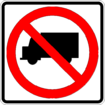 |
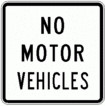 |
 |
 |
 |
 |
Support. Selective Exclusion signs give notice to road users that state or local statutes or ordinances exclude designated types of traffic or activities from using particular roadways or facilities.
Standard. If used, Selective Exclusion signs shall clearly indicate the type of traffic or activity that is excluded.
Support. Typical exclusion messages include:
A. No Trucks (R5-2);
B. NO MOTOR VEHICLES (R5-3);
C. PEDESTRIANS PROHIBITED (R5-10c);
D. NO VENDING (R5-24);
E. NO FISHING FROM BRIDGE (R5-25);
F. NO PARKING ON BRIDGE (R7-35);
G. DO NOT STOP ON TRACKS (R5-31).
Guidance. If an exclusion is governed by vehicle weight, a Weight Limit sign (see EPG 903.5.36) should be used instead of a Selective Exclusion sign.
The Selective Exclusion sign should be placed on the right-hand side of the roadway at an appropriate distance from the intersection so as to be clearly visible to all road users turning into the roadway that has the exclusion. The NO PEDESTRIANS (R5-10c) sign should be installed so as to be clearly visible to pedestrians who are at a location where an alternative route is available.
Option. The NO PEDESTRIANS (R5-10c) or No Pedestrian Crossing (R9-3a) sign may also be used at underpasses or elsewhere where pedestrian facilities are not provided.
Guidance. When the NO VENDING (R5-24) sign is used, the Missouri State Highway Patrol should be notified of the problem location. The sign should be erected no closer to the roadway than a point midway between the shoulder and the right of way line. The sign should be installed parallel to the centerline and visible from the roadway.
Option. The NO VENDING (R5-24) sign may be used at locations where vending is taking place on right of way.
Standard. When used, the NO FISHING FROM BRIDGE (R5-25) sign shall be mounted at or near the bridge ends.
Option. The NO FISHING FROM BRIDGE (R5-25) sign may be used at locations where fishing from a bridge creates a safety hazard.
Guidance. The NO PARKING ON BRIDGE sign (R7-35) should be used at bridge ends or on bridges where motorists tend to block or endanger through traffic by parking on the bridge.
The DO NOT STOP ON TRACKS sign (R5-31) should be used at locations where railroad tracks are close enough to an intersection that motorists may have a tendency to stop the vehicle on the railroad tracks.
903.5.23 ONE WAY Signs (R6-1, R6-2) (MUTCD Section 2B.40)
 |
Standard. Except as provided in the Option below, the ONE WAY (R6-1 or R6-2) sign shall be used to indicate streets or roadways upon which vehicular traffic is allowed to travel in one direction only. ONE WAY signs shall be placed parallel to the one-way street at all access points that intersect one-way roadways as shown in EPG 903.16 Typical Signing Applications.
At an intersection with a divided highway that has a median width at the intersection itself of 30 ft. or more, ONE WAY signs shall be placed, visible to each crossroad approach, on the near right and far left corners of each intersection with the directional roadways.
At an intersection with a divided highway that has a median width at the intersection itself of less than 30 ft., Keep Right (R4-7) sign and/or ONE WAY signs shall be installed. If Keep Right signs are installed, they shall be placed as close as practical to the approach ends of the medians and shall be visible to traffic on the divided highway and each crossroad approach. If ONE WAY signs are installed, they shall be placed on the near right and far left corners of the intersection and shall be visible to each crossroad approach.
Option. ONE WAY signs may be omitted on the one-way roadways of divided highways, where the design of interchanges indicates the direction of traffic on the separate roadways. The ONE WAY (R6-2) signs may be used in lieu of the ONE WAY (R6-1) signs on mast arms for signals or where lateral space is limited.
Standard. If used, at unsignalized intersections, with one-way streets, ONE WAY signs shall be placed on the near right and the far left corners of the intersection facing traffic entering or crossing the one-way street (see EPG 903.16 Typical Signing Applications).
If used at signalized intersections, with one-way streets, ONE WAY signs shall be placed near the appropriate signal faces, on the poles holding the traffic signals, on the mast arm or span wire holding the signals, or at the locations specified for unsignalized intersections.
At unsignalized T-intersections where the roadway at the top of the T-intersection is a one-way roadway, ONE WAY signs shall be placed on the near right and the far side of the intersection facing traffic on the stem approach (see EPG 903.16 Typical Signing Applications).
At signalized T-intersections where the roadway at the top of the T-intersection is a one-way roadway, ONE WAY signs shall be placed near the appropriate signal faces on the poles holding the traffic signals, on the mast arm or span wire holding the signals, or at the locations specified for unsignalized intersections.
Support. Typical locations for the ONE WAY sign include ramp terminals, crossovers, and some unusual intersections.
903.5.24 Wrong-Way Traffic Control at Interchange Ramps (MUTCD Section 2B.41)
Standard. At interchange exit ramp terminals where the ramp intersects a crossroad in such a manner that wrong-way entry could inadvertently be made, the following signs shall be used (see Fig. 903.5.21.1):
A. At least one ONE WAY sign for each direction of travel on the crossroad shall be placed where the exit ramp intersects the crossroad.
B. At least one DO NOT ENTER sign shall be conspicuously placed near the downstream end of the exit ramp in positions appropriate for full view of a traveler starting to enter wrongly from the crossroad.
C. At least one WRONG WAY sign shall be placed on the exit ramp facing a traveler traveling in the wrong direction.
Guidance. In addition, the following pavement markings should be used (see Figure 903.5.21.1):
A. On two-lane paved crossroads at interchanges, double solid yellow lines should be used as a center line for an adequate distance on both sides approaching the ramp intersections.
B. Where crossroad channelization or ramp geometrics do not make wrong-way movements difficult, a lane-use arrow should be placed in each lane of an exit ramp near the crossroad terminal where it will be clearly visible to a potential wrong-way traveler.
Option. The following traffic control devices may be used to supplement the signs and pavement markings described in this article:
A. Additional ONE WAY signs may be placed, especially on two-lane rural crossroads, appropriately in advance of the ramp intersection to supplement the required ONE WAY sign(s).
B. Additional WRONG WAY signs may be used.
C. Slender, elongated wrong-way arrow pavement markings (see EPG 620.2.20) intended primarily to warn wrong-way travelers that they are traveling in the wrong direction may be placed upstream from the ramp terminus (see Fig. 903.5.21.1) to indicate the correct direction of traffic flow. Wrong-way arrow pavement markings may also be placed on the exit ramp at appropriate locations near the crossroad junction to indicate wrong-way movement. The wrong-way arrow markings may consist of pavement markings or bidirectional red-and-white raised pavement markers or other units that show red to wrong-way travelers and white to other travelers.
D. Lane-use arrow pavement markings may be placed on the exit ramp and crossroad near their intersection to indicate the permissive direction of flow.
Guidance. On interchange entrance ramps where the ramp merges with the through roadway and the design of the interchange does not clearly make evident the direction of traffic on the separate roadways or ramps, a ONE WAY sign visible to traffic on the entrance ramp and through roadway should be placed on each side of the through roadway near the entrance ramp merging point as illustrated in Fig. 903.5.21.2.
Option. At locations where engineering judgment determines that a special need exists, other standard warning or prohibitive methods and devices may be used as a deterrent to the wrong-way movement.
Where there are no parked cars, pedestrian activity, or other obstructions such as snow or vegetation, and if an engineering study indicates that a lower mounting height would address wrong-way movements on freeway or expressway exit ramps, a DO NOT ENTER sign(s) and/or a WRONG WAY sign(s) that is located along the exit ramp facing a road user who is traveling in the wrong direction may be installed at a minimum mounting height of 3 ft., measured vertically from the bottom of the sign to the elevation of the near edge of the pavement.
Support. Refer to EPG 903.5.25 for additional information on signing to avoid wrong-way movements at at-grade intersections on expressways.
903.5.25 Divided Highway Crossing Signs (R6-3, R6-3a, R6-3b) (MUTCD Section 2B.42)
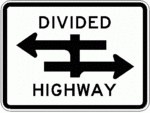 |
 |
 |
Standard. On unsignalized minor-street approaches from which both left turns and right turns are permitted onto a divided highway that has a median width at the intersection itself of 30 ft. or more, except as provided in the paragraph below, a Divided Highway Crossing (R6-3 or R6-3a) sign shall be used to advise road users that they are approaching an intersection with a divided highway.
If a Divided Highway Crossing sign is used at a four-legged intersection, the R6-3 sign shall be used. If used at a T-intersection, the R6-3a sign shall be used.
The Divided Highway Crossing sign shall be located on the near right corner of the intersection, mounted beneath the STOP or YIELD sign or on a separate support. The DIVIDED HIGHWAY (R6-3b) sign may be used in situations where the R6-3 or R6-3a Divided Highway Crossing signs may be confusing.
903.5.26 Parking, Standing and Stopping Signs (R7 and R8 Series) (MUTCD Section 2B.46)
 |
 |
 |
 |
 |
 |
 |
 |
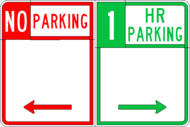 |
 |
Support. Signs governing the parking, stopping and standing of vehicles cover a wide variety of regulations, and only general guidance can be provided here. The word “standing” when used on the R7 and R8 series of signs refers to the practice of a driver keeping the vehicle in a stationary position while continuing to occupy the vehicle. Typical examples of parking, stopping, and standing signs and plaques are as follows:
1. NO PARKING ANYTIME (R7-1);
2. NO PARKING ANYTIME (DOUBLE ARROW) (R7-1D);
3. NO PARKING ANYTIME (LEFT ARROW) (R7-1L);
4. NO PARKING ANYTIME (RIGHT ARROW) (R7-1R);
5. NO STOPPING OR STANDING (R7-4a);
6. NO STOPPING OR STANDING (DOUBLE ARROW) (R7-4aD);
7. NO STOPPING OR STANDING (LEFT ARROW) (R7-4aL);
8. NO STOPPING OR STANDING (RIGHT ARROW) (R7-4aR);
9. RESERVED PARKING for Persons with Disabilities (R7-8);
10. RESERVED PARKING for Persons with Disabilities (DOUBLE ARROW) (R7-8D);
11. RESERVED PARKING for Persons with Disabilities (LEFT ARROW) (R7-8L);
12. RESERVED PARKING for Persons with Disabilities (RIGHT ARROW) (R7-8R);
13. NO TRUCK PARKING (R7-33);
14. PARRALEL PARKING ONLY (R7-34);
15. PARRALEL PARKING ONLY (DOUBLE ARROW) (R7-34D);
16. PARRALEL PARKING ONLY (LEFT ARROW) (R7-34L);
17. PARRALEL PARKING ONLY (RIGHT ARROW) (R7-34R);
18. NO PARKING (R8-3):
19. NO PARKING EXCEPT SUNDAY AND HOLIDAYS (R7-103);
20. NO PARKING ALL TRAILORS AND TRUCKS OVER 6 TONS (R7-36);
21. ½ HOUR PARKING (R7-108);
22. ½ HOUR PARKING (DOUBLE ARROW) (R7-108D);
23. ½ HOUR PARKING (LEFT ARROW) (R7-108L);
24. ½ HOUR PARKING (RIGHT ARROW) (R7-108R);
25. NO PARKING LOADING ZONE (R7-106);
26. NO PARKING LOADING ZONE (DOUBLE ARROW) (R7-106D);
27. NO PARKING LOADING ZONE (LEFT ARROW) (R7-106L);
28. NO PARKING LOADING ZONE (RIGHT ARROW) (R7-106R);
29. NO PARKING BUS STOP (R7-107);
30. NO PARKING BUS STOP (DOUBLE ARROW) (R7-107D);
31. NO PARKING BUS STOP (LEFT ARROW) (R7-107L);
32. NO PARKING BUS STOP (RIGHT ARROW) (R7-107R);
33. COMBINATION OF ANY TWO PARKING SIGNS (R7-200); and
34. TOW AWAY ZONE (R7-201aP).
The District Engineer is authorized to act on requests for parking restrictions within incorporated areas upon receipt of a city ordinance requesting the same.
Option. The District Engineer may authorize parking restrictions after completion of a study by the district staff and review by county and local law enforcement.
Within interchange areas and on ramps the standard NO PARKING ANYTIME (R7-1) sign may be used.
Guidance. Local law enforcement agencies involved should be advised of the change and have city support.
903.5.26.1 Design of Parking, Standing and Stopping Signs (MUTCD Section 2B.47)
Support. Discussions of parking signs and parking regulations in this article apply not only to parking, but also to standing and stopping.
Standard. The legend on parking signs shall state applicable regulations. Parking signs shall comply to the standards of shape, color, and location.
Where parking is prohibited at all times or at specific times, the basic design for parking signs shall have a red legend and border on a white background (Parking Prohibition signs), except that the R8-4 and R8-7 signs and the alternate design for the R7-201aP plaque shall have a black legend and border on a white background, and the R8-3 sign shall have a black legend and border and a red circle and slash on a white background. Where only limited-time parking or parking in a particular manner are permitted, the signs shall have a green legend and border on a white background (Permissive Parking signs).
Guidance. Variations in sign legend may be requested. If signs different from those listed are required, the following information may be included in the legend on the R7-10x series:
A. The restriction or prohibition;
B. The times of the day that it is applicable, if not at all hours; and
C. The days of the week that it is applicable, if not every day.
If the parking restriction applies to a limited area or zone, the limits of the restriction should be shown by arrows or supplemental plaques. If arrows are used and if the sign is at the end of a parking zone, there should be a single-headed arrow pointing in the direction that the regulation is in effect. If the sign is at an intermediate point in a zone, there should be a double-headed arrow pointing both ways. When a single sign is used at the transition point between two parking zones, it should display a right and left arrow pointing in the direction that the respective restrictions apply.
Where special parking restrictions are imposed during heavy snowfall, Emergency Snow Route (R7-203) signs should be installed. The legend will vary according to the regulations, but the signs should be vertical rectangles, having a white background with the upper part of the plate a red background.
Option. To minimize the number of parking signs, blanket regulations that apply to a given district may, if legal, be posted at district boundary lines.
As an alternate to the use of arrows to show designated restriction zones, word messages such as BEGIN, END, HERE TO CORNER, HERE TO ALLEY, THIS SIDE OF SIGN, or BETWEEN SIGNS may be used.
Where parking is prohibited during certain hours and time-limited parking or parking in a particular manner is permitted during certain other time periods, two 18 in. x 24 in. parking signs may be used with the red Parking Prohibition sign installed above or to the left of the green Permissive Parking sign.
The words NO PARKING may be used as an alternative to the No Parking symbol. The supplemental educational plaque, NO PARKING, with a red legend and border on a white background, may be used above signs incorporating the No Parking symbol.
Alternate designs for the R7-107 sign may be developed such as the R7-107a sign. Alternate designs may include, on a single panel, a transit logo, an approved bus symbol, a parking prohibition, the words BUS STOP, and an arrow. The preferred bus symbol color is black, but other dark colors may be used. Additionally, the transit logo may be shown on the bus face in the appropriate colors instead of placing the logo separately. The reverse side of the sign may contain bus routing information.
To make the parking regulations more effective and to improve public relations by giving a definite warning, a sign reading TOW-AWAY ZONE (R7-201aP) may be appended to, or incorporated in, any parking prohibition sign.
903.5.26.2 Placement of Parking, Stopping and Standing Signs (MUTCD Section 2B.48)
Guidance. When signs with arrows are used to indicate the extent of the restricted zones, the signs should be set at an angle of not less than 30 degrees or more than 45 degrees with the line of traffic flow in order to be visible to approaching traffic.
Spacing of signs should be based on legibility and sign orientation. If the zone is unusually long, signs showing a double arrow should be used at intermediate points within the zone.
Standard. If the signs are mounted at an angle of 90 degrees to the curb line, two signs shall be mounted back-to-back at the transition point between two parking zones, each with an appended THIS SIDE OF SIGN (R7-202P) supplemental plaque.
Guidance. If the signs are mounted at an angle of 90 degrees to the curb line, signs without any arrow or appended plaque should be used at intermediate points within a parking zone, facing in the direction of approaching traffic. Otherwise the standards of placement should be the same as for signs using directional arrows.
903.5.27 NO PARKING ALL TRAILERS AND TRUCKS OVER 6 TONS (R7-36)
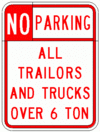
Standard. NO PARKING ALL TRAILERS AND TRUCKS OVER 6 TONS (R7-36) signs shall be placed in each commuter parking lot. A sign shall be installed at or near each entrance of the commuter parking lot.
Support. This parking restriction is necessary because commuter lots have been used by commercial trailers and trucks for extended periods of parking.
903.5.28 RESERVED PARKING For Persons with Disabilities Sign (R7-8, R7-8P)
 |
Standard. The RESERVED PARKING for Persons with Disabilities (R7-8) sign shall be installed in rest area parking lots 10 ft. to 16 ft. from the edge of the handicap ramp.
Where parking spaces that are reserved for persons with disabilities are designated to accommodate wheelchair vans, a VAN ACCESSIBLE (R7-8P) plaque shall be mounted below the R7-8 sign. The R7-8P plaque shall have a green legend and border on a white background.
Support. The R7-8L has a left arrow and the R7-8R a right arrow. The R7-8 does not have an arrow.
903.5.29 Emergency Restriction Signs (MUTCD Section 2B.49)
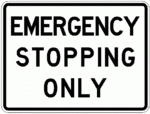
Option. The EMERGENCY STOPPING ONLY (R8-7) sign may be used to discourage or prohibit shoulder parking on the interstate and other freeway highway systems based on Section 304.024 RSMo.
Standard. EMERGENCY STOPPING ONLY signs shall be rectangular and have a black legend and border on a white background.
Guidance. The use of the EMERGENCY STOPPING ONLY sign should be held to a minimum and not erected unless there is a specific problem.
903.5.30 Traffic Signal Signs (R10-3, R10-5 through R10-30) (MUTCD Sections 2B.53 and 2B.54)
 |
 |
 |
 |
 |
 |
 |
 |
 |
 |
 |
 |
 |
 |
 |
 |
 |
 |
 |
 |
Support. Refer to EPG 902 Signals for more information on the application of these signs.
Option. To supplement traffic signal control, Traffic Signal signs R10-3 through R10-30 may be used to regulate road users.
Traffic Signal signs may be installed at certain locations to clarify signal control. Among the legends that may be used for this purpose are STOP HERE ON RED (R10-6) for observance of stop lines, DO NOT BLOCK INTERSECTION (R10-7) for avoidance of traffic obstructions, DO NOT BLOCK ENTRANCE (R10-7a), RIGHT TURN SIGNAL (R10-10R), LEFT TURN YIELD ON FLASHING ARROW (R10-27a), and STOP HERE ON FLASHING RED (R10-14b) for emergency-vehicle hybrid beacon.
Standard. The R10-3e and R10-3j sign shall be used with pre-timed pedestrian signals. For actuated pedestrian signal, the R10-3eL or R10-3jL and the R10-3eR or R10-3jR shall be mounted immediately above or incorporated in pedestrian pushbutton units.
The LEFT TURN SIGNAL (R10-10L) has been discontinued. These signs shall remain in place until the circular red indication is replaced with a red left arrow (see EPG 902.5.25 Signal Indications for Protected Only Mode Left-Turn Movements).
If an existing R10-10L is at the end of its service life, it shall be removed and the circular red indication shall be replaced with a red left arrow.
Option. The RIGHT TURN SIGNAL (R10-10R) sign does not restrict right turns on red by state law, however, if local ordinances or enforcement practices cause this restriction, this sign may be omitted.
Standard. The LEFT TURN YIELD ON FLASHING ARROW (R10-27a) shall be used next to a signal indication where the turning movement is controlled by a flashing yellow arrow and shall be mounted adjacent to the head.
Guidance. RIGHT TURN SIGNAL signs should not be used at ramp terminals, the stems of tee intersections, or any other situation where there is no opposing through or left turning traffic.
Except as provided by the option below, if right turn on red (RTOR) is restricted, then the NO TURN ON RED (R10-11a) sign shall be used in lieu of the RIGHT TURN SIGNAL sign.
Option. Where space considerations warrant, the square NO TURN ON RED (R10-11b) sign may be used.
Standard. The EMERGENCY SIGNAL (R10-13) sign shall be used in conjunction with emergency-vehicle traffic control signals.
The EMERGENCY SIGNAL – STOP ON FLASHING RED (R10-14) sign shall be used in conjunction with emergency-vehicle hybrid beacons.
Option. If needed for extra emphasis, a STOP HERE ON FLASHING RED (R10-14b) sign may be installed with an emergency-vehicle hybrid beacon.
If the signalized intersection has push buttons but no pedestrian heads the PUSH BUTTON FOR GREEN SIGNAL (R10-4) sign may be used instead of the R10-3e and R10-3j signs.
In order to remind drivers who are making turns to yield to pedestrians, Turning Vehicles Yield to Pedestrians (R10-15) sign may be used.
A RIGHT TURN ON RED MUST YIELD TO U-TURN (R10-30) sign may be installed to remind road users that they must yield to conflicting U-turn traffic on the street or highway on to which they are turning right on a red signal after stopping. A RIGHT TURN MUST YIELD TO U-TURN (special sign) sign may be installed under a yield sign to remind road users that they must yield to conflicting U-turn traffic on the street or highway on to which they are turning right controlled by a yield sign.
The R10-25 sign may be used where a pushbutton detector has been installed for pedestrians to activate In-Roadway Warning Lights or flashing beacons that have been added to the pedestrian warning signs.
Guidance. The LEFT TURN YIELD ON GREEN (symbolic green ball) (R10-12) sign and the LEFT TURN SIGNAL YIELD ON GREEN (symbolic green ball) (R10-21) are being phased out and should be replaced by the LEFT TURN YIELD ON FLASHING ARROW (R10-27a) sign as permissive left turn signals are being converted to the flashing yellow arrow indication (see EPG 902.5.29 Guidelines for Use of the Flashing Yellow Left Arrow). Existing R10-12 and R10-21 signs should be maintained until the signal is converted.
Standard. The NO TURN ON RED (R10-11a) sign shall be used to prohibit a right turn on red.
Guidance. The RIGHT TURN SIGNAL (R10-10R) sign should be used when a right turn movement with an exclusive turn lane is protected and controlled by a three-section head consisting of R-Yrt-Rt (see Fig. 902.5.31). If used, the NO TURN ON RED sign should mounted adjacent to the far right signal indication. Refer to EPG 902.5.33 to determine when a NO TURN ON RED sign should be considered.
Support. EPG 902.6 Pedestrian Control Features contains information regarding the application of the R10-32P plaque.
903.5.31 Photo Enforced Signs and Plaques (R10-18, R10-18a, R10-18aP and R10-19aP) (MUTCD Section 2B.55)
 |
 |
 |
Standard. If used below a regulatory sign, the PHOTO ENFORCED (R10-19aP) sign shall be a rectangle with a black legend and border on a white background.
Support. In November 2010, FHWA granted interim approval (IA-12) for the optional use of a regulatory Traffic Signal Photo Enforced (R10-18a) sign. For more information about the provisions of the interim approval, visit the IA-12 section of the MUTCD.
Standard. The Traffic Signal Photo Enforced (R10-18a) sign shall be used on a photo enforced approach to a signalized intersection. On photo enforced approaches where no YIELD sign is present for right turns, the INCLUDES RIGHT TURN (R10-18aP) plaque shall be installed below the Traffic Signal Photo Enforced sign.
The Traffic Signal Photo Enforced (R10-18a) sign shall not be used on a signal approach that is not photo enforced, even if other approaches to the same signal are photo enforced.
Support. For more information about photo enforcement requirements, see EPG 950 Automated Traffic Enforcement.
903.5.32 KEEP OFF MEDIAN Sign (R11-1) (MUTCD Section 2B.57)
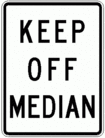
Option. The KEEP OFF MEDIAN (R11-1) sign may be used to prohibit driving into or parking on the median.
Guidance. The KEEP OFF MEDIAN sign should be installed on the left of the roadway within the median at random intervals as needed wherever there is a tendency for encroachment.
Support. A median is the area between two roadways of a divided highway measured from edge of travel way to edge of travel way or the area between a highway and an outer road.
903.5.33 ROAD CLOSED Sign (R11-2) and LOCAL TRAFFIC ONLY Signs (R11-3 Series, R11-4) (MUTCD Section 2B.58)
 |
 |
 |
 |
Guidance. The ROAD CLOSED (R11-2) sign should be installed where roads have been closed to all traffic (except authorized vehicles). ROAD CLOSED—LOCAL TRAFFIC ONLY (R11-3a) or ROAD CLOSED TO THRU TRAFFIC (R11-4) signs should be used where through traffic is not permitted, or for a closure some distance beyond the sign, but where the highway is open for local traffic up to the point of closure.
Standard. The Road Closed (R11-2, R11-3 series, and R11-4) signs shall be designed as horizontal rectangles. These signs shall be preceded by the applicable Advance Road Closed warning sign with the secondary legend AHEAD and, if applicable, an Advance Detour warning sign.
Option. The word message BRIDGE OUT may be substituted for the ROAD CLOSED message where applicable.
903.5.34 DO NOT DRIVE ON SHOULDER Sign (R4-17) (MUTCD Section 2B.36)
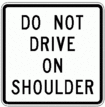
Guidance. The DO NOT DRIVE ON SHOULDER (R4-17) sign should be considered for special conditions if there is a need determined by district Traffic engineering staff. The sign should be considered as a temporary tool to aid in the enforcement of the condition. After it appears the problem has been corrected, these signs should be removed.
Standard. So that driver expectancy does not require general use of this sign, select only a relatively few locations for this sign’s use.
903.5.35 STOP FOR SCHOOL BUS Sign (R16-26)
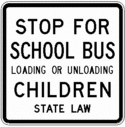
Standard. The STOP FOR SCHOOL BUS (R16-26) sign has been discontinued. MoDOT shall no longer provide STOP FOR SCHOOL BUS (R16-26) signs. Existing STOP FOR SCHOOL BUS (R16-26) signs shall be left in place until they reach the end of their service life.
903.5.36 Weight Limit Signs (R12 Series) (MUTCD Section 2B.59)
Support. In 2022, a new load posting policy was implemented by MoDOT in our EPG. This new policy resulted from a plan of corrective action with FHWA. With this new policy, all structures on the national bridge inventory will be categorized under this new policy within the next 10 years. There are 10,387 structures on the state system. 270 of these structures are major or unusual structures and these will be categorized over the next 10 years. The remaining 10,117 structures consist of 6,940 normal bridges and 3,177 culverts. The normal bridges will be categorized in the next 4 years and the culverts will be reviewed in the last 3 years of the 10 year timeline of the plan. The R12-1 sign remains in use with the remaining MoDOT bridge posting signs being replaced by one of three new three new bridge posting signs in this section.
Standard. Weight limit signs shall be installed in accordance with the new bridge posting classifications once completed. Signs shall be located in advance of the applicable bridge structure in accordance with (see Table 903.5.36 and Figures 903.5.36.1 to 903.5.36.3).
In commercial zones, bridges with the capacity of more the 65 tons shall not be posted, as normally loads in excess of 65 tons will not occur.
Once a bridge has been categorized, the bridge posting signs shall be updated within 30 days of the bridge posting reclassification. This includes installing the correct sign and configuring the sign locations to match the appropriate bridge posting figure (see Fig. 903.5.36.1 to 903.5.36.3).
Support. If existing weight limit signs need to be replaced prior to a bridge being categorized, contact Highway Safety and Traffic Division, Signing Section, for guidance.
903.5.36.1 Weight/Speed Restriction Signing (R12 Series)
| Statewide Legal Load Posting Gross Weight Categories | |||||
|---|---|---|---|---|---|
| Classification | Category | Description | Sign Verbiage | Sign | Figure |
| Normal Legal | SW-1 | No Posting Required | N/A | N/A | N/A |
| Normal Legal | SW-2 | General Gross Weight Limit | Weight Limit XX Tons | R12-1 | 903.5.36.1 |
| Normal Legal | SW-3 | Single Unit Vehicle Gross Weight Limit | Weight Limit Single Unit XX Tons | R12-12 | 903.5.36.1 |
| Normal Legal | SW-4 | Combination Vehicle Gross Weight Limit | Weight Limit Combination XX Tons | R12-13 | 903.5.36.1 |
| Normal Legal | SW-5 | Single Unit Vehicle and Combination Vehicle Gross Weight Limits | Weight Limit Single Unit XX Tons Combination XX Tons | R12-14 | 903.5.36.1 |
| Statewide Legal Load Posting Centerline Restriction with Gross Weight Categories | |||||
| Classification | Category | Description | Sign Verbiage | Sign | Figure |
| Lane Restricted | LR-1 | Lane Restriction Only | N/A | N/A | 903.5.36.3 |
| Lane Restricted | LR-2 | Lane Restriction with General Gross Weight Limit | Weight Limit XX Tons | R12-1 | 903.5.36.2 |
| Lane Restricted | LR-3 | Lane Restriction with Single Unit Vehicle Gross Weight Limit | Weight Limit Single Unit XX Tons | R12-12 | 903.5.36.2 |
| Lane Restricted | LR-4 | Lane Restriction with Combination Vehicle Gross Weight Limit | Weight Limit Combination XX Tons | R12-13 | 903.5.36.2 |
| Lane Restricted | LR-5 | Lane Restriction with Single Unit Vehicle and Combination Vehicle Gross Weight Limits | Weight Limit Single Unit XX Tons Combination XX Tons | R12-14 | 903.5.36.2 |
| Commercial Zone Areas Gross Weight Categories | |||||
| Classification | Category | Description | Sign Verbiage | Sign | Figure |
| Commercial Zone | CZ-1 | No Posting Required | N/A | N/A | N/A |
| Commercial Zone | CZ-2 | General Gross Weight Limit | Weight Limit XX Tons | R12-1 | 903.5.36.1 |
| Commercial Zone | CZ-3 | Single Unit Vehicle Gross Weight Limit | Weight Limit Single Unit XX Tons | R12-12 | 903.5.36.1 |
| Commercial Zone | CZ-4 | Combination Vehicle Gross Weight Limit | Weight Limit Combination XX Tons | R12-13 | 903.5.36.1 |
| Commercial Zone | CZ-5 | Single Unit Vehicle and Combination Vehicle Gross Weight Limits | Weight Limit Single Unit XX Tons Combination XX Tons | R12-14 | 903.5.36.1 |
| Other Miscellaneous Load Posting Categories | |||||
| Classification | Category | Description | Sign Verbiage | Sign | Figure |
| Fire Truck | FT-1 | General Gross Weight Limit for Emergency Vehicles Included in the FAST Act, Federal Reauthorization Bill | Weight Limit XX Tons | R12-1 | 903.5.36.1 |
| Closed Bridge | K-CD | Closed to All Traffic | N/A | N/A | N/A |
| Closed Bridge | K-CIF | Closed to All Traffic as the Result of a Critical Inspection Finding | N/A | N/A | N/A |
| Other | OT-1 | For Local Agency Bridges that have Signage that Doesn't Fit the Normal Legal, Lane Restricted, or Commercial Zone Categories | N/A | N/A | N/A |
903.5.37 Weigh Station Signs (R13 series) (MUTCD Section 2B.60)
 |
 |
 |
 |
 |
Guidance. The BUSES WEIGH sign (R13-11) should be used at all weigh stations to supplement the standard weigh station signing. Requests for this sign should come from the Headquarters of the Highway Patrol and submitted to the Central Office Highway Safety and Traffic Division.
Option. The OPEN FOR PERMITS (R13-13) sign, along with an easel, may be provided to the Highway Patrol, upon request for weight stations.
Guidance. The OPEN FOR PERMITS sign should be placed by weigh station personnel near the scale house. The sign should be used by the Highway Patrol when the scale is not in operation but personnel are available to issue permits.
Standard. The OPEN FOR PERMITS sign shall not be mounted on the shoulder.
Guidance. The OPEN-CLOSED plaque (R13-15P) should be installed below all WEIGH STATION RIGHT LANE signs whenever an automatic OPEN-CLOSED sign has not been provided.
The BEFORE PULLING ONTO SCALE (R13-16) sign should be installed just to the right of the weigh scale and immediately in front thereof. A 30 in. STOP sign should be mounted above the sign.
When used, the SCALE CLOSED (R13-17) sign should be mounted on the scale gates at weigh stations.
903.5.38 Other Regulatory Signs
Option. Regulatory word message signs other than those classified and specified in the EPG and the federal Standard Highway Signs and Markings book may be developed to aid the enforcement of other laws or regulations.
Except for symbols on regulatory signs, minor modifications in the design may be permitted provided that the essential appearance characteristics are met.
Standard. Special regulatory signs shall be approved by the State Highway Safety and Traffic Engineer.
903.5.39 AUTHORIZED AND EMERGENCY VEHICLES ONLY (R5-29)
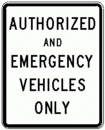
Guidance. The AUTHORIZED AND EMERGENCY VEHICLES ONLY (R5-29) sign, along with the symbolic, No U Turn (R3-4) sign, should be provided at emergency crossovers to prohibit non-emergency use. The symbolic, No U Turn sign should be installed above the AUTHORIZED AND EMERGENCY VEHICLES ONLY sign.
Signing for both directions of traffic should be provided on one post with the signs being installed 90 degrees to the roadway. The signs should be mounted back to back. The post should be located approximately in the middle of the median. If median width is greater than 60 ft., consideration should be given to install separate signs.
903.5.40 Seatbelt Signs (R16-2, R16-3, R16-24, R16-27, R16-27a, R16-28)
 |
 |
 |
Standard. The R16-2, R16-3, R16-24 and R16-27a seatbelt signs have been discontinued. These signs shall remain in place to the end of their service life.
The BUCKLE UP – IT’S THE LAW (R16-27) sign shall be installed at the end of the on ramp of rest areas and Missouri Welcome Centers on the interstate system, but shall not be installed at any other location along a roadway.
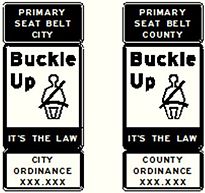
Support. A growing number of cities and counties are passing local ordinances to make seat belt usage a primary law in their communities. To promote the use of seat belts a PRIMARY SEAT BELT CITY / COUNTY - ORDINANCE (see assemblies to the right) sign may be installed by MoDOT upon request.
Standard. If a city/county has an established primary seat belt ordinance, MoDOT will install PRIMARY SEAT BELT CITY / COUNTY - ORDINANCE signs upon request once a copy of the ordinance has been received. When the PRIMARY SEAT BELT CITY / COUNTY - ORDINANCE is installed they shall be mounted to the right of the city limit sign or the entering county line sign.
Option. If insufficient space is available to mount the assembly to the right of these signs, the assembly shall be installed 200 ft. downstream of the city limit or county line signs at the appropriate sign spacing.
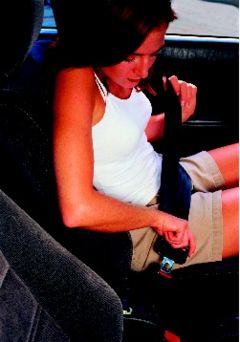
903.5.41 STATE LAW MOVE OVER OR SLOW DOWN FOR STOPPED EMERGENCY VEHICLE Sign (R16-25)

Support. The STATE LAW MOVE OVER OR SLOW DOWN FOR STOPPED EMERGENCY VEHICLES (R16-25) sign is used to inform motorists of Missouri Revised Statutes 304.022, which requires motorists to drive with caution when approaching stopped emergency vehicles.
Guidance. The STATE LAW MOVE OVER OR SLOW DOWN FOR STOPPED EMERGENCY VEHICLES sign should be installed on Interstates entering the state at the state line. The location of the sign should be as close to the state line as possible and placed at the discretion of MoDOT.
Option. Additional STATE LAW MOVE OVER OR SLOW DOWN FOR STOPPED EMERGENCY VEHICLES signs may be installed on U.S. routes entering the state where there are no adjacent interstates and rest areas at the request of the Missouri State Highway Patrol.
Standard. Requests for additional signs shall be forwarded to the appropriate district engineer for approval. These signs shall only be installed on divided highways. The installation of this sign shall not interfere with or detract from any other regulatory, warning, or guide sign.
903.5.42 Headlight Use Sign (R16-5a) (MUTCD Section 2B.64)
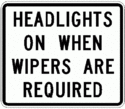
Support. The HEADLIGHTS ON WHEN WIPERS ARE REQUIRED (R16-5a) sign, supported by RSMo 307.020 in 2004, were developed to inform motorists of the new law directing them to turn on headlights when wipers are on and during inclement weather. The use of these signs have been discontinued as the law has been in place for more than 15 years and many vehicles come equipped with headlights that turn on when wipers are activated. Existing signs are to be removed at the end of their sign life.
903.5.43 Engine Brake Muffler Required Signing
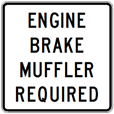
History. MoDOT once had a NOISE ORDINANCE ENFORCED policy which was developed to address cities’ requests to install NO JAKE BRAKE signing. These requests were generated when a community experienced excessive noise related to improperly installed/operated engine braking systems on commercial vehicles. Jake brakes, or engine braking systems, are safety features of commercial vehicles. MoDOT was not willing to post signs on state routes which prohibited the use of these safety devices. However, to address the increasing requests for signing, MoDOT did permit the installation of NOISE ORDINANCE ENFORCED signs if a city passed an appropriate ordinance. This program was replaced with the current ENGINE BRAKE MUFFLERS REQUIRED signing in January 2022. This change was designed to address shortcomings of the noise ordinance signing program, which included difficulty in enforcing a noise level and noise ordinances which did not contain language relevant to engine braking noise levels. The current program is based on the direction other states have taken, focusing on the physical equipment on a commercial vehicle which can be more easily inspected and evaluated for deficiencies. This signing program is also targeting the primary concern of excessive noise from engine braking.
Support. Commercial vehicles are commonly equipped with an engine braking system. These systems supplement the vehicle’s mechanical brakes aiding in slowing these heavy vehicles safely. These safety systems, when not properly installed, can create excessive noise which many communities find objectionable. MoDOT does not permit regulatory signs which prohibit the use of these safety devices, however, the ENGINE BRAKE MUFFLERS REQUIRED signing conveys to truck drivers they must use these safety devices in an appropriate manner.
Option. If a community experiences issues with excessive noise from improperly used and installed engine braking systems on commercial vehicles, they can pass an ordinance and request MoDOT to install ENGINE BRAKE MUFFLERS REQUIRED signing at their city limit sign locations. MoDOT will install and maintain these signs with only a copy of the ordinance for our records, no fee or contract is involved. A jurisdiction can pass an ordinance specifically related to engine braking or include the language as part of another ordinance, such as a noise ordinance.
Standard. Before MoDOT will install ENGINE BRAKE MUFFLERS REQUIRED signing, a city must pass an appropriate ordinance which will be approved and kept on file by CO Highway Safety and Traffic. The ordinance shall include the following language:
- Engine compression braking devices on any commercial vehicle, as defined in Missouri Revised Statute RSMo Section 301.010, may only be used within the city limits of [CITY NAME] if the truck is equipped with an adequate muffler (factory muffler or equivalent aftermarket muffler) which is properly maintained to prevent any excessive or unusual noise. If the truck’s exhaust system is equipped with a muffler cut-off, bypass, or similar device, that device shall not be activated when the engine brake is being utilized. Unmuffled engine braking system shall only be utilized within the city limits by commercial motor vehicles in emergency situations to protect life or property. Engine braking systems on rescue vehicles, city and state vehicles are exempt from this ordinance if used in the performance of official duties.
ENGINE BRAKE MUFFLER REQUIRED signing shall only be installed at the city limit location.
ENGINE BRAKE MUFFLER REQUIRED signing shall not be installed on freeways or expressways within the city limits where the posted speed limit is 45 mph or greater due to the critical need for the device at higher speeds.
Existing NOISE ORDINANCE ENFORCED signs shall be removed at the end of the signs’ service life, with no new NOISE ORDINANCE ENFORCED signs being installed after January 2022.
Individual sign installation locations can be denied by MoDOT if engineering judgement determines the prohibition would negatively impact safety, such as on long steep grades or abrupt/unexpected approaches to intersections.
Option. If the city limit on a freeway or expressway is within a posted speed limit of 45 mph or greater and the posted speed limit on that route drops to 40 mph or less, the ENGINE BRAKE MUFFLER REQUIRED sign may be installed adjacent to the speed limit sign where the speed limit drops below 45 mph.
At the end of a NOISE ORDINANCE ENFORCED sign’s life, or before, a city may request the new ENGINE BRAKE MUFFLER REQUIRED signing once the appropriate ordinance is passed.
If there is insufficient space to the right of the city limit sign to place the ENGINE BRAKE MUFFLER REQUIRED sign, it may be installed 200 ft. downstream of the city limit sign.
903.5.44 Regulatory Signs For Trash/Dumping (R5-26, R5-28)
 |
Standard. The NO DUMPING sign (R5-28) shall be erected only at locations where the Department of Natural Resources has given us written notice that solid waste is being disposed of on highway right of way. NO MORE TRASH signs (R5-26) are not typically installed along MoDOT roadways. NO MORE TRASH signs (R5-26) should only be installed at commuter lots, rest areas or roadside parks. NO MORE TRASH signs shall only be installed along the roadway if a major liter issue has been identified and the sign is needed for enforcement purposes. Existing NO MORE TRASH signs (R5-26) shall be left in place until they reach the end of their service life.
903.5.45 Regulation Signs For Roadside Parks and Commuter Parking Lots (R20-1)
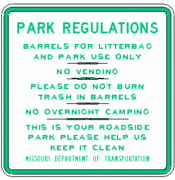
Support. Regulation signs are displayed at MoDOT maintained roadside parks and commuter parking lots to convey the rules and regulations pertaining to each type of facility.
Guidance. A minimum of one regulation sign should be installed at each MoDOT maintained roadside park and commuter parking lot, with the sign(s) being installed in centralized location(s) where the sign will be within normal sight of visitors once they leave their vehicles.
903.5.46 Rest Area Regulatory Signing (R20-2, R20-3, R20-4)
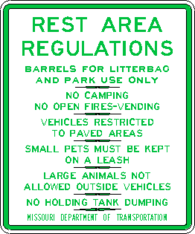 |
 |
 |
 |
 |
 |
 |
 |
|
 |
 |
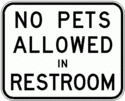 |
 |
Guidance. The REST AREA MAINTAINED BY (R20-3) sign should be installed in a prominent area along the entrance ramp to the rest area, preferably in the gore area separating truck / car traffic.
Standard. The TRUCKS-CARS (R20-4) sign shall be installed at the gore point inside the rest area to direct various vehicles to the appropriate parking lot.
A minimum of three REST AREA REGULATIONS (R20-2) signs shall be installed at each rest area.
The REST AREA MAINTAINED BY (R20-3) sign shall be installed at all rest areas to inform the public who is responsible to maintain the facility prior to the gore point.
903.5.47 Passing Lane Signs (R4-28, R4-29)
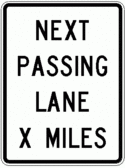 |
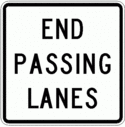 |
Support. Alternating passing lanes may be provided on rural, two-lane highways to provide motorists with an opportunity to pass slower vehicles without crossing the centerline. Where passing lanes are provided, operations and safety may be improved by giving motorists advance information about the location of passing lanes. Providing motorists with advance notice of passing lanes may reduce the number of passing maneuvers.
Standard. The NEXT PASSING LANE X MILES and the END PASSING LANES signs shall be black legend and white background and shall only be used in alternating passing lane sections.
Option. The NEXT PASSING LANE X MILES sign (R4-28) should be used beyond the end of the passing lane section to inform motorists of the distance to the next passing lane in the series.
Guidance. The END PASSING LANES (R4-29) sign should be used at the end of the alternating passing lane section to inform motorists they have reached the end of the alternating passing lane section.
903.5.48 Access Management Signing (R21-1 through R21-5)
Standard. ACCESS MANAGEMENT (R22-1 through R22-5) signs have been discontinued. MoDOT shall no longer provide ACCESS MANAGEMENT (R22-1 through R22-5) signs. Existing ACCESS MANAGEMENT (R22-1 through R22-5) signs shall be left in place until they reach the end of their service life.
903.5.49 Trucks and Buses 300 Ft Interval Sign (R4-30)
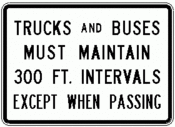
Support. The TRUCKS AND BUSES (R4-30) sign is used on routes designated as having official weigh stations.
Guidance. The TRUCKS AND BUSES (R4-30) sign should be installed on all Interstate, U.S., and State numbered highways near the state lines visible to traffic entering the state.
Option. The TRUCKS AND BUSES (R4-30) sign may be installed at locations other than the state line at the discretion of the District Traffic Engineering staff. Overuse of the TRUCKS AND BUSES sign is not recommended.
903.5.50 FINES DOUBLED ENDS Sign (R2-20)

Support: The FINES DOUBLED ENDS (R2-20) sign is not to be used on a system-wide basis. It is part of a signing package intended for special use at locations where severe crashes are occurring. There is a requirement for regional support to focus a safety campaign involving local law enforcement and public information efforts to reduce the number and severity of crashes within the travel safe zone (see EPG 907.3.2 Signing).
Standard: A FINES DOUBLED ENDS sign shall be used to mark the end of a designated travel safe zone. This sign is installed in conjunction with the TRAVEL SAFE ZONE – FINES DOUBLED (W26-1) sign.





